
1 November 2022
Mick Kinley
Chief Executive Officer
Copyright
© Australian Maritime Safety Authority
The Australian Maritime Safety Authority encourages the dissemination and exchange of information provided in this publication.
Except as otherwise specified, all material presented in this publication is provided under Creative Commons Attribution 4.0 International licence. This excludes:
- the Commonwealth Coat of Arms
- this department's logo
- content supplied by third parties.
The Creative Commons Attribution 4.0 International Licence is a standard form licence agreement that allows you to copy, distribute, transmit and adapt this publication provided that you attribute the work. The details of the version 4.0 of the licence are available on the Creative Commons website, as is the full legal code for that licence.
Third Party Copyright
Some material in this document, made available under the Creative Commons Licence framework, may be derived from material supplied by third parties. The Australian Maritime Safety Authority has made all reasonable efforts to identify content supplied by third parties using the following format ‘© [name of third party]’ or ‘Source: [name of third party]’. Permission may need to be obtained from third parties to re-use their material.
Acknowledgements
The Australian Maritime Safety Authority acknowledges the Traditional Custodians of country throughout Australia and their connections to land, sea and community.
Contact
For additional information or any enquiries about this heritage management plan, please contact:
The Australian Maritime Safety Authority
Manager Asset Management and Preparedness
PO Box 10790
Adelaide Street, Brisbane QLD 4000
Phone: (02) 6279 5000 (switchboard)
Email: Heritage@amsa.gov.au
Website: www.amsa.gov.au
Attribution
The Australian Maritime Safety Authority’s preference is that you attribute this publication (and any material sourced from it) using the following wording:
Source: Australian Maritime Safety Authority Mersey Bluff Lighthouse Heritage Management Plan – 2022
Front cover image
Figure 1. Mersey Bluff Lighthouse (Source: AMSA, 2020)
More information
For enquiries regarding copyright including requests to use material in a way that is beyond the scope of the terms of use that apply to it, please contact us through our website: www.amsa.gov.au

Mersey Bluff Lighthouse
Heritage Management Plan
2022
Table of Contents
Executive summary
- Introduction
- Background and purpose
- Heritage management plan objectives
- Methodology
- Status
- Authorship
- Acknowledgements
- Language
- Previous reports
- Sources of information and images
2. Mersey Bluff Lighthouse site
2.1 Location
2.2 Setting and landscape
2.3 Lease and ownership
2.4 Access
2.5 Listings
3. History
3.1 General history of lighthouses in Australia
3.2 The Commonwealth Lighthouse Service
3.3 Tasmanian lighthouse management administration
3.4 Mersey Bluff: a history
3.5 Building a lighthouse
3.6 Chronology of major events
3.7 Changes and conservation over time
3.8 Summary of current and former uses
3.9 Summary of past and present community associations
3.10Unresolved questions or historical conflicts
3.11Recommendations for further research
4. Fabric
4.1 Register
4.2 Related object and associated AMSA artefacts
4.3 Comparative analysis
5. Heritage significance
5.1 Commonwealth Heritage Listing – Mersey Bluff Lighthouse
5.2 TAS State Heritage Register – Mersey Bluff Lighthouse
5.3 Condition and integrity of the Commonwealth heritage values
5.4 Gain and loss of heritage values
6. Opportunities and Constraints
6.1 Implications arising from significance
6.2 Framework – sensitivity to change
6.3 Statutory and legislative requirements
6.4 Operational requirements and occupier needs
6.5 Proposals for change
6.6 Potential pressures
6.7 Processes for decision-making
7. Conservation management policies
8. Policy implementation plan
8.1 Plan and schedule
8.2 Monitoring and reporting
9. Appendices
Appendix 1. Glossary of heritage conservation terms
Appendix 2. Glossary of historic lighthouse terms relevant to Mersey Bluff
Appendix 3. Table demonstrating compliance with the EPBC Regulations
Appendix 4. Mersey Bluff current light details
Appendix 5. Document detailing 1921 acetylene explosion inside Mersey Bluff Lighthouse &
Transcription
Appendix 6. Notice to Mariners. Mersey Bluff Lighthouse – Intended alteration in colour of
Tower (1929).
Endnotes
Reference list
List of Figures
Figure 1. Cover photo of the Mersey Bluff Lighthouse (© AMSA, 2020)
Figure 2. Planning process applied for heritage management (Source: Australia ICOMOS, 1999)
Figure 3. Location of Mersey Bluff Lighthouse (Map Data © 2021 Google, NASA, TerraMetrics)
Figure 4. Mersey Bluff, Devonport (Map data: © 2021 Google, CNES/Airbus, Maxar Technologies)
Figure 5. Setting and landscape of Mersey Bluff – views from Lighthouse (© AMSA, 2013)
Figure 6. Mersey Bluff Lighthouse Map of AMSA lease, 2018 (Map data: © Esri, DigitalGlobe, GeoEye, Earthstar Geographics, CNES/Airbus DS, USDA, USGS, AeroGRID, IGN, and the GIS User Community)
Figure 7. View of access road from lighthouse (© AMSA, 2017)
Figure 8. Incandescent oil vapour lamp by Chance Brothers (Source: AMSA)
Figure 9. Dioptric lens on display at Narooma (Source: AMSA, 2011)
Figure 10. Dalén’s system - sunvalve, mixer, flasher and cylinder (Source: AMSA)
Figure 11. Huckson & Hutchison design blueprint for Mersey Bluff Lighthouse 1889. NAA: A9568, 5/7/1 (© Commonwealth of Australia, National Archives of Australia)
Figure 12. Mersey Bluff [picture] [ca. 1910] In: Crowther album 3, no. 16], digitised item from: W.L. Crowther Library, State Library of Tasmania
Figure 13. Proposed alteration in colour of tower, CLS 1929. NAA: P1130, 29/0062 (© Commonwealth of Australia, National Archives of Australia)
Figure 14. a) Table Cape Lighthouse (TAS) lit 1888 (Source: AMSA), and b) Mersey Bluff Lighthouse (TAS) lit 1889 (© AMSA, 2010)
Figure 15. Original document detailing acetylene explosion at Mersey Bluff Lighthouse, 1921. NAA: P1130, 29/0006 (© Commonwealth of Australia, National Archives of Australia)
Figure 16. Notice to Mariners regarding 1929 alteration to tower colour. NAA: P1130, 29/0062 (© Commonwealth of Australia, National Archives of Australia)
Acronym List
List of acronyms utilised throughout this heritage management plan:
Acronym | Definition |
AGA | Gas Accumulator Company |
AMSA | Australian Maritime Safety Authority |
AMSG | Australian Maritime Systems Group |
AtoN | Aid to Navigation |
BBT | Barbier, Benard, et Turenne |
CHL | Commonwealth Heritage List |
EPBC Act | Environment Protection and Biodiversity Conservation Act 1999 (Cth) |
EPBC Regulations | Environment Protection and Biodiversity Conservation Regulations 2000 (Cth) |
HMP | Heritage Management Plan |
IALA | International Association of Marine Aids to Navigation and Lighthouse Authorities |
LED | Light emitting diode |
NAA | National Archives of Australia |
NES | National Environmental Significance |
NLA | National Library of Australia |
RMS | Record Management System |
RNE | Register for the National Estate (non-statutory archive) |
THR | Tasmanian Heritage Register |
Executive Summary
Mersey Bluff Lighthouse is a historic site recognised by both Commonwealth and State governments for its heritage significance. The lighthouse was placed on the Commonwealth Heritage List in 2004 due to its contribution to the development of Devonport and the Mersey District, and its status as a significant local landmark.
Mersey Bluff Lighthouse is listed on the Tasmanian State Heritage Register for its association with the early settlement and development of the surrounding region, and the expansion of the shipping trade along the Tasmanian coast. The site is also recognised for its representation of principal late 19th century lighthouse characteristics, and its standing as an important local landmark within the township of Devonport. This site is also of high cultural significance to the Tommeginne People.
Built in 1889, the lighthouse is situated on Mersey Bluff, a promontory located along the northern coast of Tasmania within Mersey District. Originally accompanied by superintendents’ quarters, a flag pole, tide house and signal shed, the lighthouse tower is now the only structure found at the site and is leased by AMSA.
The tower is fitted with a 4th Order Chance Brothers & Co. lens and exhibits a light-emitting diode (LED) source operated on an automated mechanism as part of AMSA’s network of marine aids to navigation (AtoN). The equipment is serviced by AMSA’s maintenance contractor who visits at least once each year. AMSA officers visit on an ad hoc basis for auditing, project and community liaison purposes.
This heritage management plan concerns the lighthouse, but also considers the management of the surrounding land which is managed by the Minister administering the Crowns Lands Act 1976 (Tas). The plan is intended to guide decisions and actions of AMSA who continues to operate the lighthouse. AMSA has prepared this plan to integrate the heritage values of the lighthouse in accordance with the Environment Protection and Biodiversity Conservation Act 1999 Cth (EPBC Act), and the Environment Protection and Biodiversity Conservation Regulations 2000 Cth (EPBC Regulations).
Well-built and generally well-maintained, the lighthouse is in relatively good, stable condition. The policies and management guidelines set out in this heritage management plan strive to ensure the Commonwealth heritage values of Mersey Bluff Lighthouse are recognised, maintained and preserved for future generations.

- Introduction
- Background and Purpose
The Australian Maritime Safety Authority (AMSA) is the Commonwealth agency responsible for coastal AtoN. AMSA’s network includes the Mersey Bluff Lighthouse, built in 1889.
Section 341S of the Environment Protection and Biodiversity Conservation Act 1999 (Cth) (EPBC Act requires AMSA to prepare a management plan for Mersey Bluff Lighthouse that addresses the matters prescribed in Schedules 7A and 7B of the Environment Protection and Biodiversity Conservation Regulations 2000 (Cth) (EPBC Regulations). The principal features of this management plan are:
- a description of the place, its heritage values, their condition and the method used to assess its significance
- an administrative management framework
- a description of any proposals for change
- an array of conservation policies that protect and manage the place
- an implementation plan
- ways the policies will be monitored and how the management plan will be reviewed.
AMSA has prepared this heritage management plan to guide the future conservation of the place. This plan provides the framework and basis for the conservation and best practice management of the Mersey Bluff Lighthouse in recognition of its heritage values. The policies in this plan indicate the objectives for identification, protection, conservation and presentation of the commonwealth heritage values of the place. Figure 2 shows the basic planning process applied.
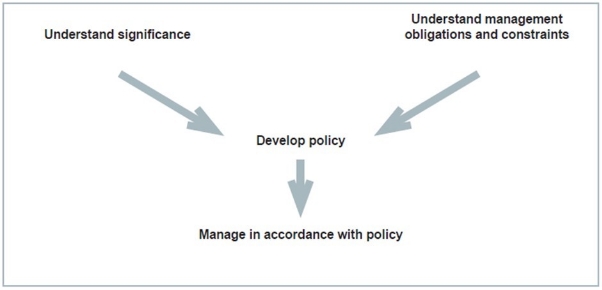
Figure 2. Planning process applied for heritage management (Source: Australia ICOMOS, 1999)
1.2 Heritage management plan objectives
The objectives of this heritage management plan are to:
- protect, conserve and manage the Commonwealth heritage values of the Mersey Bluff Lighthouse
- interpret and promote the Commonwealth heritage values of the Mersey Bluff Lighthouse
- manage use of the lighthouse
- use best practice standards, including ongoing technical and community input, and apply best available knowledge and expertise when considering actions likely to have a substantial impact on Commonwealth heritage values.
In undertaking these objectives, this plan aims to:
- Provide for the protection and conservation of the heritage values of the place while minimising any impacts on the environment by applying the relevant environmental management requirements in a manner consistent with Commonwealth heritage management principles.
- Take into account the significance of the region as a cultural landscape occupied by Aboriginal people over many thousands of years.
- Recognise that the site has been occupied by lease holders since the late 19th century.
- Encourage site use that is compatible with the historical fabric, infrastructure and general environment.
- Record and document maintenance works, and changes to the fabric in the Mersey Bluff Lighthouse fabric register (see 4.1 Fabric).
The organisational planning cycle and associated budgeting process is used to confirm requirements, allocate funding and manage delivery of maintenance activities. Detailed planning for the AtoN network is managed through AMSA’s internal planning processes.
An interactive map showing many of AMSA’s heritage sites, including Mersey Bluff Lighthouse, can be found at AMSA Heritage Lighthouses Interactive MapP0F[1]P.
1.3 Methodology
The methodology used in the preparation of this plan is consistent with the recommendations of The Burra Charter[2] and with the requirements of Chapter 5, Part 15 Division 1A of the EPBC Act. In particular, the plan:
- details the history of the site based on information sourced from archival research, expert knowledge, and documentary resources,
- provides a description of the site based on information sourced from site inspection reports and fabric registers, and;
- details the Commonwealth heritage criteria satisfied by Mersey Bluff Lighthouse as set out by schedule 7A of the EPBC Regulations.
The criterion set out at Schedule 7A (h) (i-xiii) informed the development of the required policies for the management of the Mersey Bluff Lighthouse, in conjunction with input from the Department of Agriculture, Water and the Environment on best practice management.
Consultations
In the process of preparing the plan, AMSA sought engagement with the Six Rivers Aboriginal Corporation in March 2021 under direction from the Department of Primary Industries, Parks, Water and Environment TAS (Aboriginal Heritage Tasmania). AMSA has yet to receive a response and future plans will outline the progress of this consultation.
AMSA also consulted with the Devonport City Council who provided comments on statutory/legislative requirements, and emphasized the significance of the lighthouse within the local community.
The draft management plan was advertised in accordance with the EPBC Act and EPBC Regulations. On the 22 December 2021 a notice was placed in The Australian newspaper publication which invited the general public to review the draft plan and provide feedback. Public consultation closed on the 20 January 2022. Submissions received from the general public were incorporated in the final document.
AMSA submitted the draft plan to the Heritage Branch of the Department of Agriculture, Water and the Environment who provided feedback on the draft. These comments were incorporated into the final document. A developed draft was submitted to the Australian Heritage Council and was endorsed by the Minister for the Environment on 14 July 2022.
Future updates and amendments will be listed here.
1.4 Status
This plan has been adopted by AMSA in accordance with Schedule 7A (Management plans for Commonwealth Heritage places) and Schedule 7B (Commonwealth Heritage management principles) of the EPBC Regulations to guide the management of the place and for inclusion in the Federal Register of Legislative Instruments.
1.5 Authorship
This plan has been prepared by AMSA. At the initial time of publication, Australian Maritime Systems Group (AMSG) is the contract maintenance provider for the Commonwealth Government’s AtoN network including Mersey Bluff Lighthouse.
1.6 Acknowledgements
AMSA acknowledges the professional assistance of the Aboriginal Heritage Tasmania (Department of Primary Industries, Parks, Water and Environment, TAS), and the Devonport City Council.
1.7 Language
For clarity and consistency, some words in this plan such as restoration, reconstruction and preservation, are used with the meanings defined in Burra Charter[3]. (See Appendix 1 Glossary of heritage conservation terms). Also see Appendix 2 Glossary of lighthouse terminology relevant to Mersey Bluff which sets out the technical terminology used in this plan.
1.8 Previous reports
A Heritage Lighthouse Report was prepared by Mr Peter Marquis-Kyle for AMSA in 2007.
A Heritage Asset Condition Report was prepared by AMSG for AMSA in 2016, and updated in 2019.
1.9 Sources of information and images
This plan has used a number of sources of information. This includes the National Archives of Australia (NAA), the National Library of Australia (NLA) and AMSA’s heritage collection.

2. Mersey Bluff Lighthouse site
2.1 Location
Situated on Mersey Bluff, the Mersey Bluff Lighthouse is located at 39 Bluff Access Road, Devonport, Tasmania. The lighthouse is approximately 2 km north of the township of Devonport and overlooks Bass Strait.
Coordinates: 41° 09.5269’ S, 146° 21.3317’ E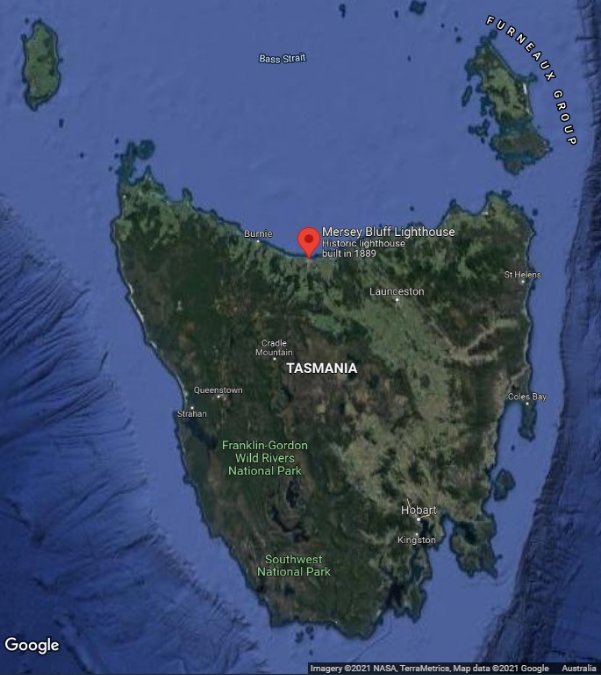
Figure 3. Location of Mersey Bluff Lighthouse within Tasmania (Map data: ©2021 Google, NASA, TerraMetrics)
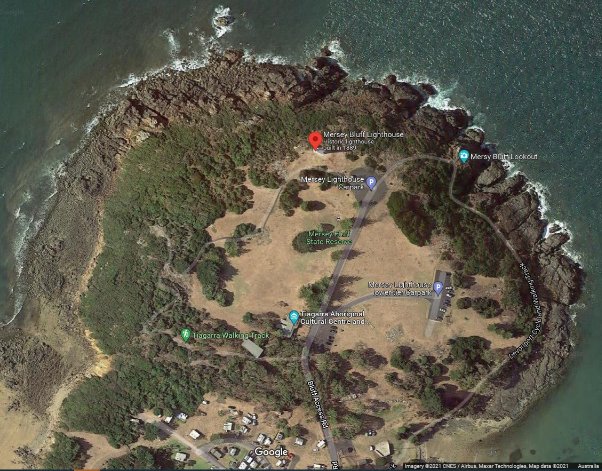
Figure 4. Mersey Bluff, Devonport (Map data: ©2021 Google, CNES/Airbus, Maxar Technologies)
2.2 Setting and landscape
The lighthouse is situated on Mersey Bluff, a rocky coastal promontory overlooking Bass Strait. The bluff is approximately 1.6 kilometres east of the mouth of Don River and approximately 1.2 kilometres west of the mouth of the Mersey River. It is located within the Mersey River catchment.
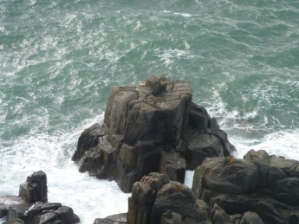

Figure 5. Setting and landscape of Mersey Bluff - view from Lighthouse (© AMSA, 2013)
Fauna and flora
The endangered central north burrowing crayfish, Engaeus granulatus, is found along the coast of Devonport including Mersey Bluff.
Humpback breeding grounds have been recorded along Tasmania’s north coast within Bass Strait which includes Devonport’s coastline.
2.3 Lease and ownership
AMSA lease the lighthouse and land from the Minister administering the Crowns Lands Act 1976 (Tas).
The AMSA lease consists of one parcel of land, Lot 1 CPR 4034, with a total surface area of 200 metre-squared2 (See Figure 6. for map of lease). The current lease commenced on 1 May 1998 for a period of 25 years, with the option to renew for a further 25 years.
Mersey Bluff Lighthouse is the only remaining structure from the lightstation. The land surrounding AMSA’s lease area is managed by the Minister administering the Crowns Lands Act 1976 (Tas).

Figure 6. Mersey Bluff Lighthouse Map of AMSA lease, 2018 (Map data: © Esri, DigitalGlobe, GeoEye, Earthstar Geographics, CNES/Airbus DS, USDA, USGS, AeroGRID, IGN, and the GIS User Community)
2.4 Access
Mersey Bluff Lighthouse can be publicly accessed via Bluff Access Road, a sealed vehicle track which terminates as a vehicle parking site and cul-de-sac. The Devonport Cycle and Walking Track also leads to the lighthouse and can be accessed 24/7 by the general public.
All visitors are required to walk the remaining 50 metres to base of tower. The general public is able to walk around the base of the lighthouse, however access inside the tower is restricted to authorised personnel only.
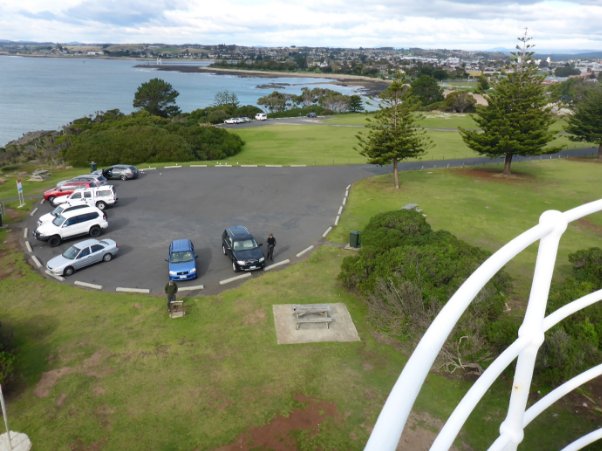
Figure 7. View of access road from lighthouse (© AMSA, 2017)
2.5 Listings
Mersey Bluff Lighthouse is listed on the following heritage registers:
Place ID | |
Commonwealth Heritage List | 105377[4] |
Tasmanian Heritage Register | 1382[5] |
Register of the National Estate (non-statutory archive) | 12070[6] |

3. History
3.1 General history of lighthouses in Australia
The first lighthouse to be constructed on Australian soil was Macquarie Lighthouse, located at the entrance to Port Jackson, NSW. First lit in 1818, the cost of the lighthouse was recovered through the introduction of a levy on shipping. This was instigated by Governor Lachlan Macquarie, who ordered and named the light.
The following century oversaw the construction of hundreds of lighthouses around the country. Constructing and maintaining a lighthouse were costly ventures that often required the financial support of multiple colonies. However, they were deemed necessary aids in assisting the safety of mariners at sea. Lighthouses were firstly managed by the colony they lay within, with each colony developing their own style of lighthouse and operational system. Following Federation in 1901, which saw the various colonies unite under one Commonwealth government, lighthouse management was transferred from state hands to the Commonwealth Lighthouse Service.
Lighthouse technology has altered drastically over the centuries. Eighteenth century lighthouses were lit using parabolic mirrors and oil lamps. Documentation of early examples of parabolic mirrors in the United Kingdom, circa 1760, were documented as consisting of wood and lined with pieces of looking glass or plates of tin. As described by Searle, ’When light hits a shiny surface, it is reflected at an angle equal to that at which it hit. With a light source is placed in the focal point of a parabolic reflector, the light rays are reflected parallel to one another, producing a concentrated beam’.[7]
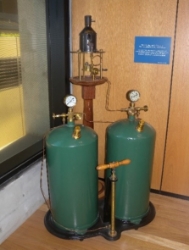
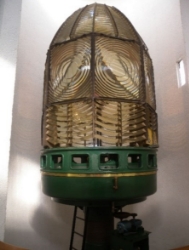
Figure 8. Incandescent oil vapour lamp by Chance Brothers (Source: AMSA)
Figure 9. Dioptric lens on display at Narooma (Source: AMSA, 2011)
Early Australian lighthouses were originally fuelled by whale oil and burned in Argand lamps, and multiple wicks were required in order to create a large flame that could be observed from sea. By the 1850s, whale oil had been replaced by colza oil, which was in turn replaced by kerosene, a mineral oil.
In 1900, incandescent burners were introduced. This saw the burning of fuel inside an incandescent mantle, which produced a brighter light with less fuel within a smaller volume.
Light keepers were required to maintain pressure to the burner by manually pumping a handle as can be seen in Figure 8.
P9F
In 1912, Swedish engineer Gustaf Dalén, was awarded the Nobel Prize in physics for a series of inventions relating to acetylene-powered navigation lights. Dalén’s system included the sun valve, the mixer, the flasher, and the cylinder containing compressed acetylene. Due to their efficiency and reliability, Dalén’s inventions led to the gradual destaffing of lighthouses. Acetylene was quickly adopted by the Commonwealth Lighthouse Service from 1915 onwards.
Large dioptric lenses, such as that shown in Figure 9, gradually decreased in popularity due to cost and the move towards unmanned automatic lighthouses. By the early 1900s, Australia had stopped ordering these lenses with the last installed at Eclipse Island in Western Australia in 1927. Smaller Fresnel lenses continued to be produced and installed until the 1970s when plastic lanterns, still utilising Fresnel’s technology, were favoured instead. Acetylene remained in use until it was finally phased out in the 1990s.
In the current day, Australian lighthouses are lit and extinguished automatically using mains power, diesel generators, and solar-voltaic systems.

Figure 10. Dalén's system - sunvalve, mixer and flasher (Source: AMSA)
3.2 The Commonwealth Lighthouse Service
When the Australian colonies federated in 1901, they decided that the new Commonwealth government would be responsible for coastal lighthouses—that is, major lights used by vessels travelling from port to port—but not the minor lights used for navigation within harbours and rivers. There was a delay before this new arrangement came into effect. Existing lights continued to be operated by the states.
Since 1915, various Commonwealth departments have managed lighthouses. AMSA, established under the Australian Maritime Safety Authority Act 1990 (Cth), is now responsible for operating Commonwealth lighthouses and other aids to navigation, along with its other functions.
3.3 Tasmanian lighthouse management administration
The table below outlines the timeline for Tasmanian lighthouse management.
Time Period | Administration |
1915-1927:
1927-1963:
1963-1972:
1972-1982:
1982-1983:
1983-1985:
1985-1987:
1987-1990:
1991- | Lighthouse District No. 3 (Victoria, New South Wales, Tasmania), Hobart Headquarters.
Deputy Director of Lighthouses and Navigation, Tasmania.
Department of Shipping and Transport, Regional Controller, Tasmania.
Department of Transport [III], Regional Controller, Tasmania.
Department of Transport and Construction. Victoria-Tasmania Region, Transport Division (Tasmania).
Department of Transport [IV] Victoria-Tasmania Region, Hobart Office.
Department of Transport [IV], Tasmanian Region.
Department of Transport and Communications, Tasmanian Region.
Australian Maritime Safety Authority.
|
3.4 Mersey Bluff: a history
Aboriginal history
The history of the bluff stretches back thousands of generations, and there are many sites of Aboriginal heritage significance located mere meters from the lighthouse tower. This includes middens, tea tree living grounds, and petroglyphs. Stone artefacts were also found on the bluff, many of which have been removed.
Further consultation with the local Aboriginal Corporation will be reflected in this section future versions of the plan.
Early European history
The Mersey River was first traversed by European explorers in 1823, but the landscape was deemed unfavourable for settlement. In 1826 however, the establishment of the Van Diemen’s Land Co. resulted in the region being explored, surveyed and settled – headed by Captain Bartholomew Boyle Thomas.
The settlements of Torquay and Formby were established in 1851 and 1853 respectively – Torquay on the eastern bank of the Mersey River and Formby on the western. By 1854, a wharf and other port facilities had been completed, and the trading of agricultural produce and timber increased significantly. In 1890, the settlements of Torquay and Formby amalgamated creating the township of Devonport.[8]
3.5 Building a lighthouse
Why Mersey Bluff?
Prior to the installation of a lighthouse, an obelisk was mounted on Mersey Bluff that could be observed for some distance from sea. However, the obelisk could not be sighted after nightfall nor during cloudy conditions, leaving mariners entering the river from the westward completely unguided. Owing to the ever-increasing popularity of Formby (later Devonport) as a hub for agricultural and timber trade, the Marine Board determined that a light should be established on the Bluff in place of the obelisk.[9] The Bluff’s position at the mouth of the Mersey River ensured the safe passage of mariners entering from Bass Strait.
Design
Mersey Bluff Lighthouse was designed by Huckson and Hutchison of Hobart. The original 1889 blueprint design illustrated a circular brick structure complete with capstone and weather vane.
Huckson & Hutchinson Huckson & Hutchinson was founded in 1887 by Robert Huckson and R. Hutchinson. The firm was responsible for the design of many Tasmanian lighthouses including Table Cape, Mersey Bluff, Eddystone Point, Maatsuyker, Cape Sorrell, and Low Head. The firm also designed various alterations and necessary repairs to lightstations across the state.
|

Figure 11. Huckson & Hutchison design blueprint for Mersey Bluff Lighthouse 1889. NAA: A9568, 5/7/1 (© Commonwealth of Australia, National Archives of Australia)
Construction
In June of 1888, tenders were called for the building of the lighthouse, superintendent’s house, flagpole, tide house and signal shed. Messrs T and F Duff were chosen as the successful tenders with a cost of £1,559. Construction commenced on 16 October 1888 – which was reportedly “…carried out in a most substantial manner”.[10] Constructed with a cement concrete foundation, the brick tower stood on a “plinth of solid basalt” with a cap of white Bellerive sandstone.[11] The lighthouse was completed less than 12 months after commencing with work officially ceasing on 28 of May 1889.
The Mersey Bluff lighthouse was officially opened on 2 September 1889.[12]
Equipment when built
Following completion, Mersey Bluff Lighthouse stood fitted with a 4th Order Chance Bros. dioptric lens. The light could be observed for a distance of 12 miles weather permitting.[13]
The lighthouse tower was accompanied by a Superintendent’s quarters, signal shed, tide house and flagpole.
Superintendents (lightkeepers) were stationed at the lighthouse. Reports indicate two keepers were stationed there in 1912, a third having been removed just previously.
The lighthouse was de-staffed in 1920 following its conversion to automatic electric operation.
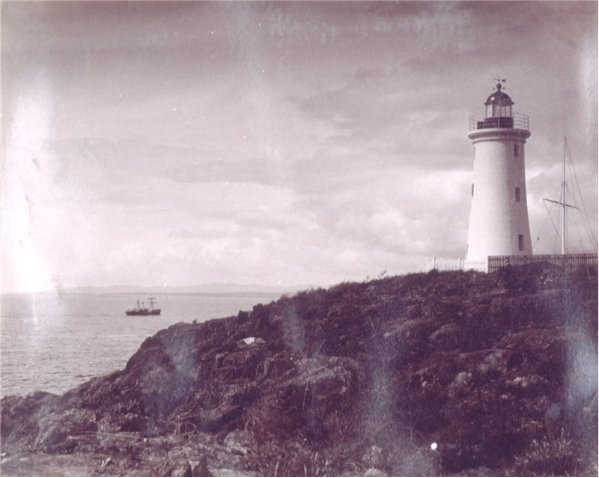
Figure 12. Mersey Bluff [picture] [ca. 1910] In: Crowther album 3, no. 16], digitised item from: W.L. Crowther Library, State Library of Tasmania
3.6 Chronology of major events
The following table details the major events to have occurred at Mersey Bluff Lighthouse from its construction in 1889 to present day.
Date | Event |
2 Sept 1889 | Mersey Bluff Lighthouse officially opened.
|
1920 | Lighthouse de-staffed following conversion to DC Electric operation.[14]
|
Nov 1921 | Acetylene explosion inside lantern room damages 4th Order Chance Bros. lens. (see Appendix 5. for original and transcribed report of 1921 explosion).
|
1929 | Vertical red stripes painted on tower (see Appendix 6. for Notice to Mariners)
|
1966
| Keepers’ houses demolished.
|
1976
| Tiagarra Aboriginal Cultural Centre and Museum established on bluff nearby lighthouse.
|
2004 | Mersey Bluff Lighthouse listed on Commonwealth Heritage List.
|
3.7 Changes and conservation over time
Due to advances in lighthouse technology over the 19th, 20th and 21st centuries, the Mersey Bluff Lighthouse has undergone a number of changes, both technological and physical, to improve its function as a marine AtoN.
The Brewis Report
Commander C.R.W.Brewis, RN retired naval surveyor was commissioned in 1911 by the Commonwealth Government to report on the condition of existing lights and to recommend any additional ones. Brewis visited every lighthouse in Australia between June and December 1912 and produced a series of reports published in their final form in March 1913. These reports were the basis for decision-making on lighthouse use across the country.
Below is the report Brewis collated on his visit to the Mersey Bluff Lighthouse, and his accompanying recommendations.[15]
MERSEY BLUFF LIGHT (20 miles from Low Head.) Lat. 41º 9’ S., Long. 146º 23’ E., Charts Nos. 1695a and 1079.- Established in the year 1889, and recently converted to acetylene. Signal station by day. Flags. Connected by telephone with Devonport. Character.- One white, with red sectors, fixed dioptric, about 500 c.p. Illuminant, acetylene gas. Colt seven-day acetylene generator. Brick tower, 42 feet. Height of focal plane, 116 feet above high water. Visible – white, in clear weather, 16 nautical miles; red, 7 miles. Condition and State of Effciency.- The light-house tower, apparatus, and dwellings are in servicable condition. The light requires to be given a more distinctive character. There are two light-keepers at this station. Until recently there were three. There is no necessity for more than one light-keeper, as the light is of an unwatched character, and the staff should be regulated accordingly. Communication.- By road, 2 miles to Devonport. Quarterly by steamer, carrying stores by contract. Tide Signals.- Tide signals have been established recently in the light-house reserve, and an arrange- ment entered into by the Mersey Marine Board with the light-keeper’s family for the display of the signals. Leading Lights.- The Harbour Leading Lights which are situated near the wharves, and 2 miles from the Bluff, are at present attended at sunset and daybreak by the Mersey Bluff light-keepers. These are not coastal lights. RECOMMENDED .- (a) The Mersey Bluff Light be given a distinctive character, by inserting a revolving or dropping shutter, actuated by clockwork mechanism (to be wound every sixteen hours), thus converting it from fixed to flashing. Light characteristic – two flashes, each of one-third second duration, in quick succession, every six seconds. (b) A 70 c.p. burner be used, increasing the power to 1,200 c.p. (c) The Harbour Leading Lights, acetylene (U.), being of a purely local character, be not taken over. They should be controlled by the Mersey Marine Board, and managed by the Harbour Master, as is done in the other States with similar lights. (d) One light-keeper be withdrawn. (e) The work connected with tide signals be permitted to be performed by the light-keeper’s family, without prejudice, and during the pleasure of the Commonwealth Government.
|
In 1929, red, vertical stripes were painted on the white Mersey Bluff Lighthouse tower to increase its visibility in the day. The alteration was made after designs were finalised by the Commonwealth Lighthouse Service, and these stripes contribute to the lighthouse's distinctive character
Alteration to the light
The following table outlines the timeline for changes made to the Mersey Bluff light.
Date | Alteration |
1910 | Lighthouse converts to acetylene operation with onsite gas generator.
|
1920 | Lighthouse converts to DC Electic operation.
|
1952 | 2nd Order Fixed Lens assembly installed. Original lens installed at the Althorpe Island Lead light (SA) from 1965-1991.
|
1978 | Lighthouse converts to mains electric operation.
|
2021 | LED lightsource installed in tower. Fixed lens assembly retained. |
Recent conservation works
The table below documents recent conservation works carried out at the lighthouse.
Date | Conservation works |
2014 | Lantern room and balcony repainted.
|
2018 | Structure repaint due to vandalism.
|
.
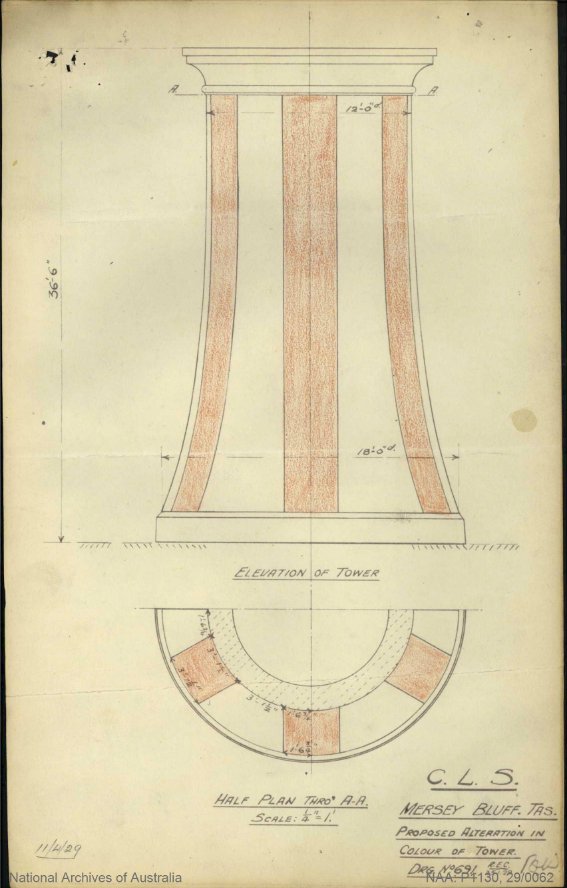
Figure 13. Proposed alteration in colour of tower, CLS 1929. NAA: P1130, 29/0062 (© Commonwealth of Australia, National Archives of Australia)
3.8 Summary of current and former uses
From its construction in 1889, Mersey Bluff Lightouse has been used as a marine AtoN for mariners at sea. Its AtoN capability remains its primary use.
3.9 Summary of past and present community associations
The lighthouse and its immediate surrounds maintains strong associations with a variety of groups.
Aboriginal associations
The Traditional knowledge-holders for the region are dedicated to exhibiting the history and culture of the bluff and surrounding area. The Six Rivers Aboriginal Corporation oversees matters concerning the bluff and Tiagarra.
In 1976, the Tiagarra Aboriginal Cultural Centre and Museum was established on the bluff which houses a large collection of artefacts and information on Aboriginal cultural heritage. Although first run by the Devonport City Council, the Tiagarra building now owned by the Aboriginal community. Further information can be found on the Centre’s website: https://tiagarra.weebly.com/
Local, national and international associations
The site’s contribution to the development of the district has cemented Mersey Bluff Lighthouse as a popular and significant local landmark. The easy access roads and walking tracks established in its vicinity indicates the site’s active inclusion in the local community. The tower and its iconic red stripes have also been identified as imperative to the Devonport City Council’s branding.
As a manned site from its construction in 1889 until 1920, Mersey Bluff Lighthouse maintains familial ties from past lightkeepers – ties which transcend local, national and international borders.
3.10 Unresolved questions or historical conflicts
Any historical conflicts and unresolved questions brought to light concerning the lighthouse’s history will be included in this section within future plans.
3.11 Recommendations for further research
Further research on the Superintendents (lightkeepers) stationed at the lighthouse would be beneficial in understanding the social history of the lighthouse. Additionally, further research into changes made to the tower and lightstation as a whole would provide greater insight into the transformation of the lightstation from its construction in 1889 to the present day.

4. Fabric
4.1 Register
The cultural significance of the lighthouse resides in its fabric, and also in its intangible aspects – such as the meanings people ascribe to it, and the connections to other places and things. The survival of its cultural value depends on a well-informed understanding of what is significant, and on clear thinking about the consequences of change. The Burra Charter[16] sets out good practice for conserving cultural significance.
Criterion listed under ‘Heritage Significance’ refer to the criterion satisfied within the specific Commonwealth heritage listing (see section 5.1).
(Images included in Sections 4.1 and 4.2 – © AMSA)
Lighthouse feature: Lantern roof
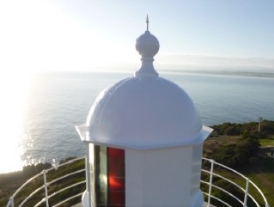
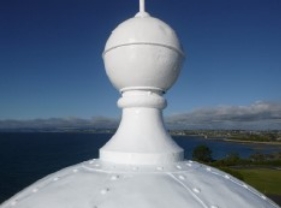

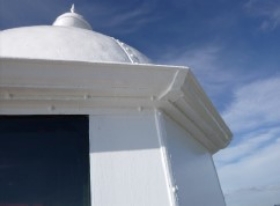
© AMSA, 2019
Description and condition
1889 Chance Bros part-spherical dome of copper sheets lapped and screwed to ribs
- Ribs – Chance Bros cast iron radial ribs
- Inner Skin – none
- Ventilator – ball type (vent holes sealed). New stainless steel vent was installed in February 2019 to reduce the moisture accumulation previously occurring in the dome
- Lightning Conductor – vertical spike on top of ball ventilator
- Gutter – polygonal fabricated gutter attached to ring of cast iron pieces bolted together
- Handrails – none
- Drip tray – copper dish suspended under ventilator, with central hole for heat tube
Finish | painted |
Condition | intact and sound |
Integrity | high |
Significance | high |
Maintenance | keep in service, prepare and repaint at normal intervals |
Rectification works | investigate moisture accumulation in dome and implement measures to reduce moisture accumulation |
Heritage significance: High
The lantern roof is both an essential and original part of a lighthouse associated with the development of Tasmanian townships (criterion a).
The lantern roof contributes to the asthetic value of the lighthouse (criterion e).
Lighthouse feature: Lantern glazing

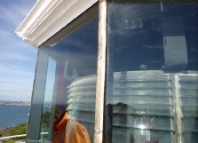
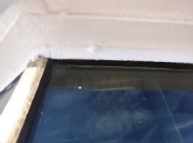
© AMSA, 2019
Description and condition
1889 Chance Bros, polygonal in form.
- Panes – flat rectangular glass, one tier.
- Astragals – Chance Bros vertical astragals of rectangular section iron, bolted to gutter ring at top, and to lantern base below.
- Downpipes – one downpipe discharging to balcony floor.
Finish | astragals and glazing strips painted |
Condition | intact and sound |
Integrity | high |
Significance | high |
Maintenance | keep in service, reglaze as necessary, prepare and repaint at normal intervals |
Rectification works | none |
Heritage significance: High
The lantern glazing is an historic and essential part of a lighthouse associated with the development of Tasmanian townships (criterion a).
The lantern glazing contributes to the aesthetic value of the lighthouse (criterion e).
Lighthouse feature: Lantern base
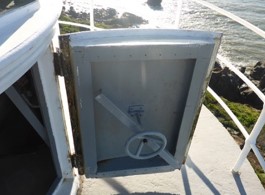
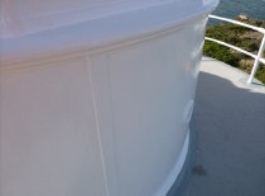
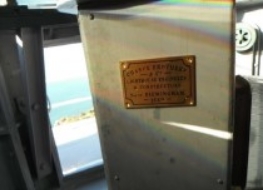
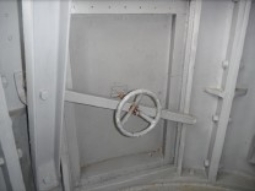
© AMSA, 2019
Description and condition
1889 Chance Bros, cylindrical in form. Curved panels of cast iron bolted together with flanged joints.
- Internal lining – none (removed).
- Vents – round air inlets cast as part of wall panels. Cast iron air trunks bolted on inside, each fitted with one brass regulator.
- Door – Chance Bros iron door with timber frame inside. Copper alloy hinges. Secured with steel strong-back, steel stud and hand-wheel.
Finish | painted |
Condition | intact and sound |
Integrity | high |
Significance | high |
Maintenance | keep in service prepare and repaint at normal intervals |
Rectification works | none |
Heritage significance: High
The lantern base is both an original and essential part of a lighthouse associated with the devleopment of Tasmanian townships (criterion a).
Lighthouse feature: Lantern floor

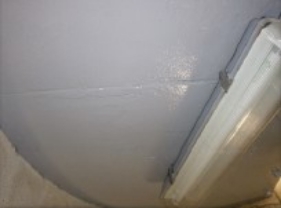

© AMSA, 2019
Description and condition
Slate slab floor supported on sandstone cornice at the top of the tower wall, and on central iron post.
Finish | painted |
Condition | intact and sound |
Integrity | high |
Significance | high |
Maintenance | keep in service prepare and repaint at normal intervals |
Rectification works | none |
Heritage significance: High
The lantern floor is an early and essential part of a lighthouse associated with the development of Tasmanian townships (criterion a).
Lighthouse feature: Lens assembly
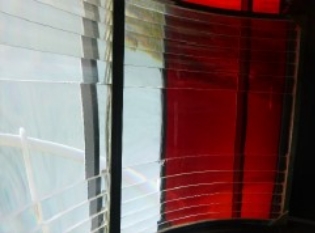
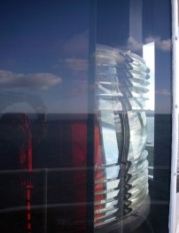 © AMSA, 2019
© AMSA, 2019
Description and condition
700mm focal radius fixed (non-rotating) lens
assembly of glass and gunmetal, with array of reflecting prisms on the landward side.
Supported by steel brackets attached to the lantern base, and by brackets attached to the lantern roof gutter ring.
Condition | intact and sound |
Integrity | high |
Significance | high |
Maintenance | keep in service clean at normal intervals |
Rectification works | none |
Heritage significance: High
The lens assembly is an early and essential part of a lighthouse associated with the development of Tasmanian townships (criterion a).
Lighthouse feature: Light source
 © AMSA, 2021
© AMSA, 2021
Description and condition
Sealite LED SL-LED-216-W.
Condition | intact and sound |
Significance | low |
Maintenance | none |
Rectification works | none |
Heritage significance: Low
Lighthouse feature: Pedestal
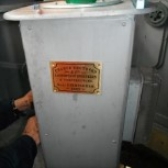
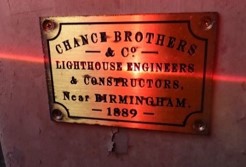 © AMSA, 2021
© AMSA, 2021
Description and condition
Recent SL-LED-PEDESTAL-03. Replica Chance Bros. maker’s plaque fit to pedestal.
Finish | painted |
Condition | intact and sound |
Integrity | high |
Significance | low |
Maintenance | none |
Rectification works | none |
Heritage significance: Low
Lighthouse feature: Balcony floor
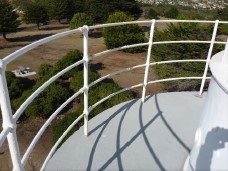
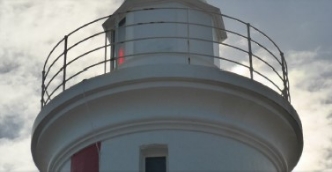
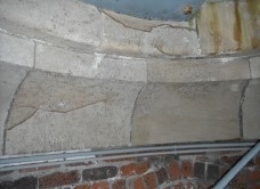 © AMSA, 2019
© AMSA, 2019
Description and condition
1889 sandstone slabs supported by tower wall and cornice.
Finish | membrane painted |
Condition | intact and sound, but there is evidence of previous water penetration into the masonry wall below. |
Integrity | high |
Significance | high |
Maintenance | keep in service monitor and maintain joint seals prepare and repaint at normal intervals |
Rectification works | none |
Heritage significance: High
The balcony floor is an original and essential part of a lighthouse associated with the development of Tasmanian townships (criterion a)
Lighthouse feature: Balcony balustrade
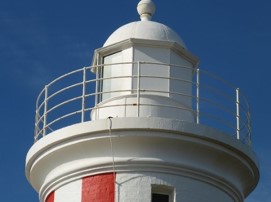
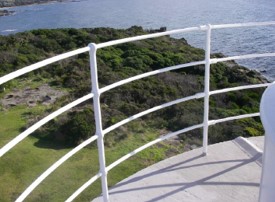
 © AMSA, 2019
© AMSA, 2019
Description and condition
1889 wrought iron balusters with four iron pipe rails.
Finish | painted |
Condition | intact and sound |
Integrity | high |
Significance | high |
Maintenance | keep in service prepare and repaint at normal intervals |
Rectification works | none |
Heritage significance: High
The balcony balustrade is an original and essential part of a lighthouse associated with the development of Tasmanian townships (criterion a).
Lighthouse feature: Walls
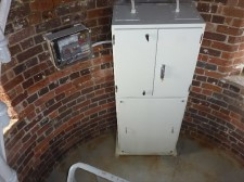

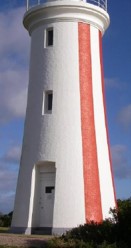 © AMSA, 2019
© AMSA, 2019
Description and condition
1889 brick walls, built with the internal face plumb so that the internal volume is of
constant diameter. The lower part of the tower is built in two skins, which are merged into one above the door opening. Two iron reinforcing bands built into the bed joints of the brickwork just below the intermediate floors, marked by a crack on the outside and visible in places inside. A new stainless steel vent was installed in 2019 to reduce moisture accumulation throughout the tower.
Finish | outside: painted inside: paint removed by sandblasting |
Condition | signs of water penetration throughout the tower moderately severe erosion of internal surface in places otherwise intact and sound |
Integrity | high |
Significance | high |
Maintenance | keep in service monitor condition of pointing and brickwork |
Rectification works | none |
Heritage significance: High
The tower walls are an original and essential part of a lighthouse associated with the development of Tasmanian townships (criterion a).
The tower walls contribute to the aesthetic value of the lighthouse (criterion e).
Lighthouse feature: Windows
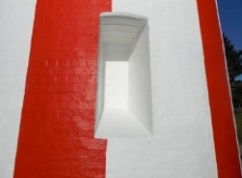
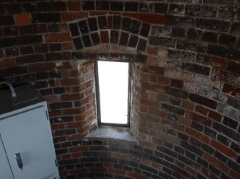

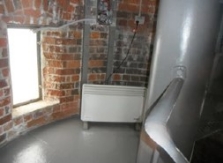
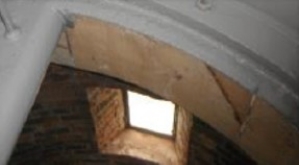 © AMSA, 2019
© AMSA, 2019
Description and condition
Eight original window openings with recent stainless steel frames built into brickwork, with stainless steel casement sashes secured with stainless steel screws. Lower two windows blanked out with stainless steel sheeting.
Finish | outside: frames and sashes painted inside: bare metal glass: clear |
Condition | intact and sound |
Integrity | high |
Significance | window openings: high frames and sashes: low |
Maintenance | keep in service prepare and repaint at normal intervals |
Rectification works | none |
Heritage significance: High
The tower windows are original and essential parts of a lighthouse associated with the development of Tasmanian townships (criterion a).
Lighthouse feature: Door
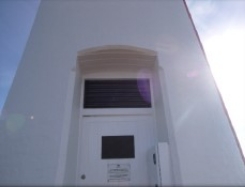
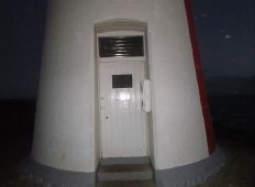
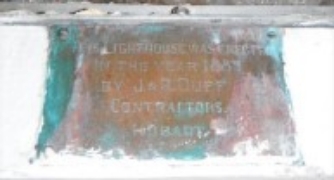 © AMSA, 2019
© AMSA, 2019
Description and condition
1889 timber framed and sheeted door hung in timber door frame. Weather proof ventilation and aluminium security mesh replaced with new stainless steel vent.
Original rim lock in place but disabled, with brass knobs inside and out. Secured with modern cylinder deadlocking rim lock.
Builder’s plate fixed to transom inside.
- Plaque – Brass plate screwed to transom over door, engraved THIS LIGHTHOUSE WAS ERECTED IN THE YEAR 1889 BY J & R DUFF, CONTRACTORS, HOBART
Finish | painted |
Condition | intact and sound |
Integrity | high |
Significance | high |
Maintenance | keep in service prepare and repaint at normal intervals |
Rectification works | none |
Heritage significance: High
The tower door is an original and essential part of a lighthouse associated with the development of Tasmanian townships (criterion a).
Lighthouse feature: Intermediate floors

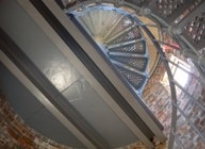
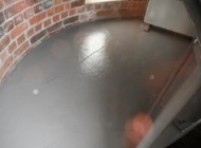 © AMSA, 2019
© AMSA, 2019
Description and condition
Two 1889 part floors forming stair landings. Slate floor slabs supported on rolled steel beams built into the tower walls.
Finish | painted |
Condition | old, stable crack in the slate floor otherwise intact and sound |
Integrity | medium |
Significance | high |
Maintenance | keep in service prepare and repaint at normal intervals |
Rectification works | none |
Heritage significance: High
The intermediate floors are an original and essential part of a lighthouse associated with the development of Tasmanian townships (criterion a).
Lighthouse feature: Stairs
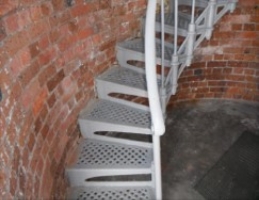


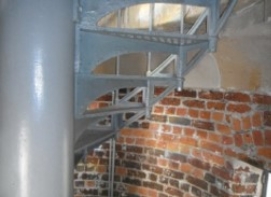
© AMSA, 2019
Description and condition
1889 geometric stair with cast iron treads/risers built into the tower wall, and wrought iron handrail and stanchions.
Finish | painted |
Condition | intact and sound |
Integrity | high |
Significance | high |
Maintenance | keep in service prepare and repaint at normal intervals |
Rectification works | none |
Heritage significance: High
The tower stairs are an original and essential part of a lighthouse associated with the development of Tasmanian townships (criterion a). _________________________________________________________________________
Lighthouse feature: Ground floor
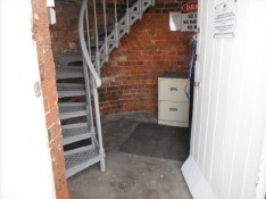
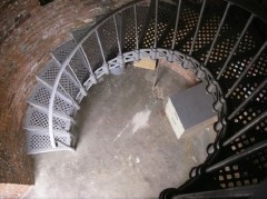
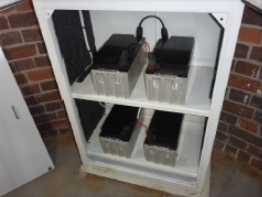
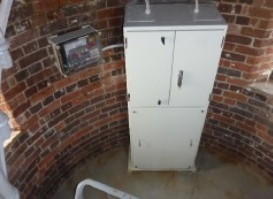
© AMSA, 2019
Description and condition
1889 concrete floor slab.
Finish | bare concrete |
Condition | intact and sound |
Integrity | high |
Significance | high |
Maintenance | keep in service |
Rectification works | none |
Heritage significance: High
The tower stairs are an original and essential part of a lighthouse associated with the development of Tasmanian townships (criterion a).
Lighthouse feature: Apron paving
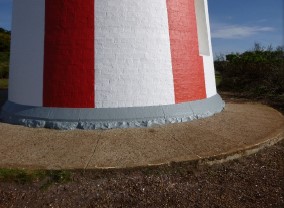
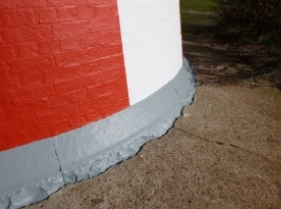
© AMSA, 2019
Description and condition
Concrete apron slab around the base of the tower, with white painted margin.
Finish | trowelled bare concrete |
Condition | stable |
Integrity | high |
Significance | moderate |
Maintenance | keep in service monitor for cracks and other erosions |
Rectification works | none |
Heritage significance: Moderate
The apron paving is an essential part of a lighthouse associated with the development of Tasmanian townships (criterion a).
4.2 Related object and associated AMSA artefact
There are currently no AMSA artefacts on display at the Mersey Bluff Lighthouse.
4.3 Comparative analysis
Mersey Bluff Lighthouse bears closest resemblance to Table Cape Lighthouse (TAS) built the year before in 1888. Although each of the structures maintain unique features, both were designed by Huckson & Hutchinson and constructed of brick with internal face plumb, therefore maintaining the same diameter. Both the tenders for the construction of the Mersey Bluff structure and the Table Cape lantern room were awarded to the Duff Bros. of Hobart
Whereas Mersey Bluff was originally installed with a 4th Order Chance Bros. dioptric lens, Table Cape was installed with a 2nd Order Chance Bros. lantern. Both lighthouses were originally painted white and are located along the north coast of Tasmania.
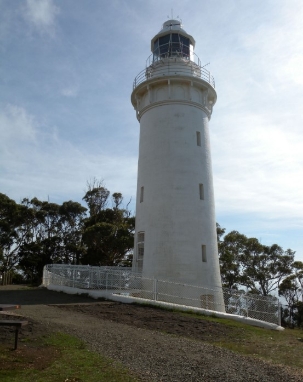
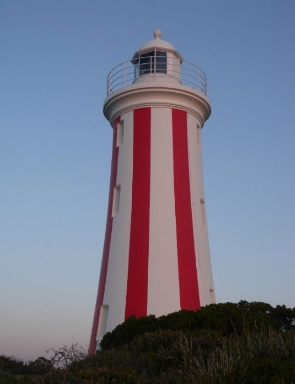
Figure 14. a) Table Cape Lighthouse (TAS) lit 1888 (Source: AMSA), b) Mersey Bluff Lighthouse (TAS) lit 1889 (© AMSA, 2010)

5. Heritage Significance
5.1 Commonwealth Heritage Listing – Mersey Bluff Lighthouse
The following statement of significance and heritage value criteria below are directly taken from the Mersey Bluff Lighthouse listing on the Commonwealth Heritage List (Place ID: 105377).
Commonwealth statement of significance
The Mersey Bluff Lighthouse, built in 1889, is significant for its association with the development of Devonport and the Mersey District. The lighthouse reflects the importance of Devonport during the late nineteenth century as a river port which was sustained by exports of agricultural produce and timber. (Criterion A) (Australian Historic themes 3.8.1 Shipping to and from Australian ports; 3.8.2 Safeguarding Australian products for long journeys and 3.16.1 Dealing with hazards and disasters).
The Mersey Bluff Lighthouse is significant as an important local landmark that forms a focal point in the recreational area of the township of Devonport and the surrounding region. (Criterion E.1).
Commonwealth heritage criteria
There are nine criteria for inclusion in the Commonwealth Heritage List – meeting any one of these is sufficient for listing a place. These criteria are similar to those used in other commonwealth, state and local heritage legislation, although thresholds differ. In the following sections, the criteria met by Mersey Bluff Lighthouse is discussed as based on the current Commonwealth Heritage Listing (Place ID 105377).
Criterion | Relevant Attributes Identified | Values |
Criterion A – Processes
This criterion is satisfied by places that have significant heritage value because of [their] importance in the course, or pattern, of Australia’s natural or cultural history.
|
| The Mersey Bluff Lighthouse, built in 1889, is significant for its association with the development of Devonport and the Mersey District. The lighthouse reflects the importance of Devonport during the late nineteenth century as a river port, which was sustained by exports of agricultural produce and timber.
|
Criterion E – Aesthetic characteristics
This criterion is satisfied by places that have significant heritage value because of [their] importance in exhibiting particular aesthetic characteristics values by a community or cultural group.
|
|
The Mersey Bluff Lighthouse is significant as an important local landmark that forms a focal point in the recreational area of the township of Devonport and the surrounding region. |
5.2 TAS State Heritage Register – Mersey Bluff Lighthouse
Mersey Bluff Lighthouse is listed on the Tasmanian Heritage Register (THR ID: 1382). The statement of significance and heritage values criteria are directly taken from the listing.
TAS statement of significance
No statement of significance is provided for places listed prior to 2007.
TAS State heritage criteria
There are eight criterions identified within the Tasmanian Heritage Register – Mersey Bluff Lighthouse meets the following three criterions.
Criteria | Explanation/evidence |
Criteria a) The place is important to the course or pattern of Tasmania’s history.
| The lighthouse is significant for its association with the early settlement and development of the surrounding region and the expansion of the shipping trade along the Tasmanian coast. |
Criteria d) The place is important in demonstrating the principal characteristics of a class of place in Tasmania’s history.
| Mersey Bluff Lighthouse, built in 1889 is of historic heritage significance because it represents the principal characteristics of a late 19th century lighthouse. |
Criteria f) The place has strong or special association with a particular community or cultural group for social or spiritual reasons.
| Mersey Bluff Lighthouse, built in 1889, is of historic heritage significance as an important local landmark which forms a focal point in the recreational area of the township of Devonport and the surrounding region. |
Mersey Bluff Lighthouse has also been identified as having local heritage significance under the Tasmanian Planning Scheme (as enacted by the Land Use Planning and Approvals Act 1993 (TAS).
These heritage values, identified and explained in the Commonwealth Heritage List and the Tasmanian Heritage Register, will form the basis of the management of Mersey Bluff Lighthouse. In the event of necessary works, all criteria will be consulted to inform best practice management of the values associated with the lighthouse. (See Section 7. Conservation management policies for further information on strategies to conserve heritage values of Mersey Bluff Lighthouse)
5.3 Condition and integrity of the Commonwealth heritage values
A heritage monitoring program was implemented in 2016. Each site is visited and reviewed every two years where the heritage fabric and values of the site are evaluated. Assessment of the condition and integrity of lighthouse’s values are derived from the latest available Heritage Asset Condition Report produced by AMSA’s maintenance contractor.
‘Condition’ is measured on a Good – Fair – Poor scale and incorporates the current condition of the specific value. Integrity is measured on a High – Medium – Low scale which incorporates the value’s intactness.
As a whole, Mersey Bluff Lighthouse’s identified values are in Good condition. These values also demonstrate high integrity. The lighthouse tower’s prominence within its landscape setting is undisputed and retains much of its original fabric.
Criteria | Values (including attributes) | Condition | Integrity |
Criterion A – Processes | The whole of the lighthouse and its historic relationship to the port.
| Good | High |
Criterion E – Aesthetic characteristics | The prominence of the lighthouse and its historic relationship to the port.
| Good | High |
5.4 Gain or loss of heritage values
Evidence for the potential gain or loss of heritage values will be documented within this section of future versions of this heritage management plan.

6. Opportunities and Constraints
6.1 Implications arising from significance
The Commonwealth statement of significance (section 5.1 above) demonstrates that Mersey Bluff Lighthouse is a place of considerable heritage value due to its contribution to the development of Devonport and the Mersey District, and its significance as an important local landmark.
The implication arising from this assessment is that key aspects of the place should be conserved to retain this significance. The key features requiring conservation include:
- architectural quality of the building
- interior spaces and features, which are notable for their design, details and/or their original lighthouse function. These include:
- intermediate floors
- ground floor
- spiral staircase
- lantern room
- external spaces and features, which are notable for their design, details, and/or their original lighthouse function. These include:
- lantern roof
- balcony
- lighthouse walls and windows
Referrals and approvals of action
The EPBC Act requires approval from the Minister for the Environment for all actions likely to have a significant impact on matters of National Environmental Significance (NES).
The Act provides that actions:
- taken on Commonwealth land which are likely to have a significant impact on the environment will require the approval of the Minister.
- taken outside Commonwealth land which are likely to have a significant impact on the environment on Commonwealth land, will require the approval by the Minister.
- taken by the Australian Government or its agencies which are likely to have a significant impact on the environment anywhere will require approval by the Minister.
The definition of ‘environment’ in the EPBC Act and EPBC Regulations includes the cultural heritage values of places.
Heritage strategy
If an Australian Government agency owns or controls one or more places with Commonwealth heritage values, it must prepare a heritage strategy within two years from the first time they own or control a heritage place (section 341ZA).
A heritage strategy is a written document that integrates heritage conservation and management within an agency’s overall property planning and management framework. Its purpose is to help an agency manage and report on the steps it has taken to protect and conserve the commonwealth heritage values of the properties under its ownership or control.
The heritage strategy for AMSA’s AtoN assets was endorsed by the Commonwealth Minister for the Environment in 2018 and is available online.P37F[17]
Heritage asset condition reports
A heritage asset condition report is a written document that details the heritage fabric of a site with an in-depth description of each architectural and structural element. The document includes: a brief history of the site, the Commonwealth Heritage statement of significance and value criteria, a heritage significance rating for each individual element, and a catalogue of artefacts on-site. The document is also accompanied by up-to-date photos of each structural element. This document operates as a tool for heritage monitoring, and is reviewed and updated biennially.
Aboriginal heritage significance
Mersey Bluff as a whole is notable for its Aboriginal heritage significance. Although these values lie outside of the Commonwealth heritage listing curtilage and AMSA’s lease, the potential remains for future works at the lighthouse to impact these values. At the time this plan was written, no plans have been made for future works at Mersey Bluff Lighthouse. In the event major works at the lighthouse are to be carried out, AMSA will seek to minimise impacts to the surrounding area by:
- Utilising specific access tracks to ensure no damage to surrounding vegetation,
- Ensuring project footprint is limited to the AMSA lease. In the unlikely instance work is required outside of this footprint, approvals will be sought from the appropriate stakeholders.
- Implementing an appropriate discovery plan in the instance Aboriginal cultural heritage is suspected and/or found.
6.2 Framework: sensitivity to change
The heritage values identified by both Commonwealth and state demonstrate Mersey Bluff Lighthouse is of high significance. Furthermore, the site maintains a strong historic relationship with the settlement of Devonport. Therefore, work actioned by AMSA on the lighthouse’s fabric harnesses the potential to reduce or eradicate the significance of the site’s heritage values.
Conservation works, including restoration and reconstruction, or adaption works of the absolute minimum so as to continue the lighthouse’s usefulness as an AtoN are the only works that should be actioned by AMSA on Mersey Bluff Lighthouse. Some exceptions are made for health and safety requirements, however any and all work carried out must be conducted in line with heritage considerations and requirements of the EPBC Act.
The table below demonstrates the level of sensitivity attributed to the various elements of the fabric register in the face of change. These are measured on a High – Medium – Low spectrum depending on the action’s possible threat to the site’s heritage values.
High sensitivity
High sensitivity to change includes instances wherein a change would pose a major threat to the heritage value of a specific fabric, or the lighthouse. A major threat is one that would lead to substantial or total loss of the heritage value.
Moderate sensitivity
Moderate sensitivity to change includes instances wherein a change would pose a moderate threat to the heritage value of a specific fabric, or would pose a threat to the heritage significance of a specific fabric in another part of the building. A moderate threat is one that would diminish the heritage value, or diminish the ability of an observer to appreciate the value.
Low sensitivity
Low sensitivity to change includes instances wherein a change would pose little to no threat to the heritage value of a specific fabric, and would pose little to no threat to heritage significance in another part of the building.
Component | Level of sensitivity | Nature of change impacting heritage values
|
Mersey Bluff Lighthouse structure | High |
|
Low |
| |
Ground floor | High |
|
Low |
| |
Intermediate floors | High |
|
Low |
| |
Stairs | High |
|
Low |
| |
Balcony | High |
|
Medium |
| |
Low |
| |
Lens assembly, pedestal | High |
|
Low |
| |
Windows, doors | High |
|
Low |
|
6.3 Statutory and legislative requirements
The following table outlines the statutory and legislative requirements relevant to the conservation and management of Mersey Bluff Lighthouse.
Act or code | Description |
Environment Protection and Biodiversity Conservation Act 1999 (Cth) | The Environment Protection & Biodiversity Conservation Act 1999 (Cth) requires agencies to prepare management plans that satisfy the obligations included in Schedule 7A and 7B of the EPBC Regulations.
|
Environment Protection and Biodiversity Conservation Regulations 2000 (Cth)
| The Commonwealth Department of Agriculture, Water and the Environment has determined these principles as essential for guidance in managing heritage properties.
(a) have a particular interest in, or associations with, the place; and (b) may be affected by the management of the place;
|
AMSA Heritage Strategy 2022-2025 | As the custodian of many iconic sites, AMSA has long recognised the importance of preserving their cultural heritage. This Heritage Strategy is in response to section 341ZA of the EPBC Regulations which obliges AMSA to prepare and maintain a heritage strategy, along with obliging AMSA to:
The strategy derives from the AMSA Corporate Plan and achievements are reported through the AMSA Annual Report. The 2020-21 AMSA Annual report can be found online.P38F[18]
|
Navigation Act 2012 (Cth) | Part 5 of the Act outlines AMSA’s power to establish, maintain and inspect marine aids to navigation (such as Mersey Bluff Lighthouse). (1) AMSA may: (a) establish and maintain aids to navigation; and (b) add to, alter or remove any aid to navigation that is owned or controlled by AMSA; and
(c) vary the character of any aid to navigation that is owned or controlled by AMSA.
(2) AMSA, or person authorised in writing by AMSA may, at any reasonable time of the day or night: (a) inspect any aid to navigation or any lamp or light which, in the opinion of AMSA or the authorised person, may affect the safety or convenience of navigation, whether the aid to navigation of the lamp or light is the property of: (i) a state or territory; or (ii) an agency of a state or territory; or (iii) any other person; and
(b) enter any property, whether public or private, for the purposes of an inspection under paragraph (a); and
(c) transport, or cause to be transported, any good through any property, whether public or private, for any purpose in connection with:
(i) the maintenance of an aid to navigation that is owned or controlled by AMSA; or (ii) the establishment of any aid to navigation by AMSA.
|
Australian Heritage Council Act 2003 (Cth) | This Act establishes the Australian Heritage Council, whose functions are:
|
TAS Historic Cultural Heritage Act 1995 (TAS)
| This Act establishes the Tasmanian Heritage Council.
7 General functions and powers of Heritage Council (1) The functions of the Heritage council are –
(a) to advise the Minister on matters relating to Tasmania’s historic cultural heritage and the measures necessary to conserve that heritage for the benefit of the present community and future generations; and
(b) to work within the planning system to achieve the proper protection of Tasmania’s historic cultural heritage; and
(c) to co-operate and collaborate with Federal, State and local authorities in the conservation of places of historic cultural heritage significance; and
(d) to encourage and assist in the proper management of places of historic cultural heritage significance; and
(e) to encourage public interest in, and understanding of, issues relevant to the conservation of Tasmania’s historic cultural heritage; and
(f) to encourage and provide public education in respect of Tasmania’s historic cultural heritage; and
(g) to assist in the promotion of tourism in respect of places of historic cultural heritage significance; and
(h) to keep proper records, and encourage others to keep proper records, of places of historic cultural heritage significance; and
(i) to perform any other function the Minister determines.
(2) The Heritage Council may do anything necessary or convenient to perform its functions.
|
Tasmanian Planning Scheme, as enacted by the Land Use Planning and Approvals Act 1993 (TAS)
| The purpose of the Local Historic Heritage Code of the Tasmanian Planning Scheme (pursuant to clause C6.1 of the Tasmanian Planning Scheme) is to: Recognise and protect: (a) the local historic significance of local places, precincts, landscapes and areas of archaeological potential; and (b) significant trees.
|
Building Code of Australia/National Constructions Code | The Code is the definitive regulatory resource for building construction, providing a nationally accepted and uniform approach to technical requirements for the building industry. It specifies matters relating to building work in order to achieve a range of health and safety objectives, including fire safety.
As far as possible, Commonwealth agencies aim to achieve compliance with the Code, although this may not be entirely possible because of the nature of and constraints provided by existing circumstances, such as an existing building.
|
Work Health and Safety Act 2011 (Cth) | The objectives of this Act include: (1) The main object of this Act is to provide for a balanced and nationally consistent framework to secure the health and safety of workers and workplaces by:
a) protecting workers and other persons against harm to their health, safety and welfare through the elimination or minimisation of risks arising from work; and
b) providing for fair and effective workplace representation, consultation, co‑operation and issue resolution in relation to work health and safety; and
c) encouraging unions and employer organisations to take a constructive role in promoting improvements in work health and safety practices, and assisting persons conducting businesses or undertakings and workers to achieve a healthier and safer working environment; and
d) promoting the provision of advice, information, education and training in relation to work health and safety; and
e) securing compliance with this Act through effective and appropriate compliance and enforcement measures; and
f) ensuring appropriate scrutiny and review of actions taken by persons exercising powers and performing functions under this Act; and
g) providing a framework for continuous improvement and progressively higher standards of work health and safety; and
h) maintaining and strengthening the national harmonisation of laws relating to work health and safety and to facilitate a consistent national approach to work health and safety in this jurisdiction.
(2) In furthering subsection (1)(a), regard must be had to the principle that workers and other persons should be given the highest level of protection against harm to their health, safety and welfare from hazards and risks arising from work as is reasonably practicable.
[Quoted from Division 2 of Act]
This has implications for Mersey Bluff Lighthouse of Australia as it is related to AMSA staff, contractors and visitors.
|
6.4 Operational requirements and occupier needs
As a working AtoN, the operational needs of Mersey Bluff Lighthouse are primarily concerned with navigational requirements. Below are the operational details and requirements of Mersey Bluff Lighthouse as outlined by AMSA.
Navigational requirement for AMSA’s AtoN site | ||
1
| Objective/rationale
| An AtoN is required on Mersey Bluff to provide both a landfall mark for Devonport and a mark for coastal navigation. A sector light arrangement is required to the east and to west to mark over the shallows, rocks and reefs that lie on either side of the safe approach sector.
|
2
| Required type(s) of AtoN
| A fixed structure is required to act as a day mark. A distinctive light is required for use at night.
|
3
| Priority/significance
| An AtoN at this site is critical for the navigation of commercial ships.
|
4
| Required measure of performance
| The service performance of the AtoN must comply with the IALA Availability Target Category 1 (99.8%).
|
5
| Primary and secondary means (if any) of identification
| The day mark must be conspicuous. The existing 16 m white round brick tower with red vertical stripes meets this requirement.
The light must comply with the requirements of rhythmic characters of light as per the IALA NAVGUIDE. The light must have distinct characteristics that are easy to recognise and identify. The present group (4) flashing white and red sector light every 20 seconds meets this requirement.
|
6
| Visual range
| During daytime, the AtoN structure should be visible from at least 5 nautical miles.
At night, the white light must have a nominal range of at least 15 nautical miles, and the red sector lights at least 10 nautical miles.
|
7
| Radar conspicuousness | As the site provides a good radar echo, no additional radar enhancement is required. |
AMSA’s goals
AMSA is responsible, under the Navigation Act, for maintaining a network of marine AtoN around Australia’s coastline that assist mariners to make safe and efficient passages. AMSA’s present network of approximately 500 marine AtoN includes traditional lighthouses such as Mersey Bluff Lighthouse, beacons, buoys, racons, automatic identification system stations, metocean sensors including broadcasting tide gauges, current meter, directional wave rider buoys and a weather station.
Technological developments in the area of vessel traffic management have also contributed to increasing navigation safety and helped promote marine environment protection. AMSA aims to meet international standards for the reliability of lighthouses set by the International Association of Marine Aids to Navigation and Lighthouse Authorities (IALA).
At the time of preparing this management plan, the major goal for Mersey Bluff Lighthouse primarily encompasses its continued utilisation as an AtoN for as long as necessary, while upkeeping the appropriate maintenance to conserve and preserve the heritage values of the lighthouse.
Lighthouse performance standards
AMSA aims to meet international standards for the reliability of lighthouses set by IALA. Mersey Bluff light is designated as an IALA Availability Category 1 AtoN (within a scale of Category 1 to Category 3, Category 1 aids are most critical). Category 1 aids have an availability target of 99.8 per cent.
Access to the lighthouse
One practical effect of this performance standard is that the operational equipment and structure of the light need to be kept in good repair by regular preventative maintenance and equipment that fails in service is repaired quickly. Routine maintenance and emergency repairs are carried out by AMSA’s maintenance contractor. The contractor needs reliable access to the site for this work, and AMSA officers need access for occasional inspection of the site including auditing the contractor’s performance.
6.5 Proposals for change
Preventative maintenance works are carried out on the lighthouse to maintain its status as a working marine AtoN, and to assist in the site’s conservation.
A list of scheduled preventative maintenance work is identified within the latest available site inspection report. The information provided below was taken from this report:
Maintenance description | Estimated maintenance date |
Mersey Bluff reseal glazing | 2025 |
Mersey Bluff lantern room paint | 2025 |
Mersey Bluff structure paint | 2029 |
6.6 Potential pressures
In the case of Mersey Bluff Lighthouse, the obligation to remove/replace original fabric materials from the lighthouse owing to unavoidable and irreversible deterioration remains a potential pressure on the site and it’s identified heritage values. At the time of preparing this management plan, no plans have been made to remove or replace original fabric materials. In the event plans are made to modify or remove heritage fabric, work will be conducted in line with the heritage considerations and requirements of the EPBC Act.
6.7 Processes for decision-making
Processes for decision-making are required in the event of an incident that impacts the heritage values of the site. The following incidents are included due to their likelihood of occurrence at the Mersey Bluff Lighthouse.
Incident | Procedure |
Major project/maintenance works proposed |
|
Damage to lighthouse’s fabric (heritage significance) |
|
Damage to lighthouse’s fabric (no heritage significance) |
|
Light upgrade |
|
Minor modification to lighthouse such as adding of attachment |
|
Unforeseen discovery of Aboriginal artefacts on-site. |
|
Divestment of lighthouse from AMSA |
|
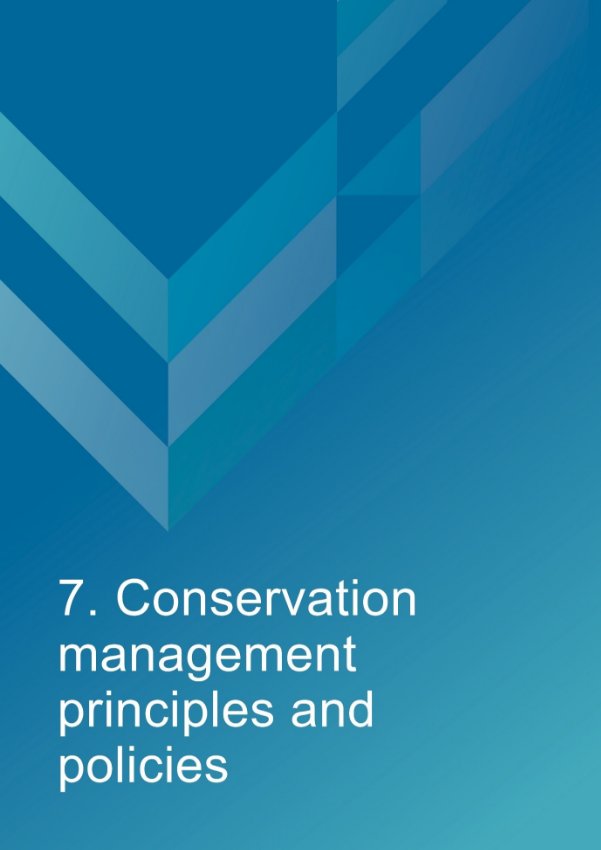
7. Conservation management principles and policies
Policies
Note: The management of sensitive information is not relevant to AMSA’s heritage strategy and therefore bears no relevance in this management plan.
Fabric and setting
Policy 1 – Protect and conserve the significant external and internal fabric of the lighthouse, including existing buildings, layout and setting.
AMSA’s main purpose is to facilitate the ongoing operation of the site as a marine AtoN while preserving the site’s heritage values. As part of a heritage monitoring program, Heritage Asset Condition Reports are produced for each site every two years to evaluate the condition of the heritage fabric and values. Routine servicing is also carried out by maintenance contractors. Regular written reports from these visits will be sent to AMSA Asset Management and Preparedness for review and any work requirements identified will be scheduled accordingly. Should for some unforeseen reason the site no longer be viable as a marine AtoN, management responsibilities will be passed to the appropriate state or federal authority to ensure preservation of the heritage assets.
Implementation strategy:
- AtoN Maintenance contractor will continue scheduled periodic maintenance of the lighthouse and marine aid to navigation every 12 months to ensure condition is monitored for early warning of deterioration. Schedule must be approved by AMSA Asset Management and Preparedness.
- AMSA Asset Management and Preparedness to arrange for maintenance to be carried out on the lighthouse as required while continuing to operate as an AMSA marine aid to navigation.
- AMSA Asset Management and Preparedness to arrange for the replacement and upgrading of marine aid to navigation equipment in the lighthouse as required to meet AMSA’s service commitment, in a manner that preserves the original fabric of the lighthouse.
- AMSA Asset Management and Preparedness to maintain information on the heritage fabric of the lighthouse including any and all actions, treatments and inspection outcomes within the heritage fabric register.
- AMSA Asset Management and Preparedness to conserve all the fabric elements identified as significant in the heritage asset condition report.
- AMSA Asset Management and Preparedness to seek expert materials conservation advice when considering repair, restoration and reconstruction of historic fabric. The relevant local, state and federal heritage approvals must be sought prior to repair, restoration and reconstruction.
- AMSA Asset Management and Preparedness to assess any development proposals to surrounding area for possible impacts on the heritage values of Mersey Bluff Lighthouse, and liaise with the appropriate state or federal heritage authorities.
- AMSA AtoN Heritage Coordinator to conserve the distinctive character of the lighthouse by collecting photographic evidence and historical documentation of the original fabric.
Uses
Policy 2 – Install and operate equipment in the lighthouse, so it continues to function as an effective marine AtoN, in such a way as to impose the least possible harm to the significant fabric.
Mersey Bluff Lighthouse’s use as a working marine AtoN is of high priority. Carrying out maintenance, including upgrades to AtoN equipment, is necessary to its function and continued marine safety along the TAS coast. In the event of the installation and/or upgrade to AtoN equipment, proper precaution will be taken to ensure the least possible harm is done to significant fabric.
Implementation strategy:
- AtoN Maintenance Contractor to monitor Mersey Bluff’s AtoN equipment every 12 months and propose maintenance in the instance of necessary installation or removal. Proposed maintenance is to be approved by AtoN Asset Management and Preparedness.
- AMSA Asset Management and Preparedness to outline all possible risks to significant fabric, external and internal, associated with the installation, removal and operation of equipment.
- AMSA Asset Management and Preparedness to ensure works carried out are those that ensure the least possible harm to significant fabric.
- AMSA Asset Management and Preparedness to seek expert heritage conservation advice on best practice management of the site during installation, removal and operation of equipment.
Policy 3 – Monitor possible impacts to the site resulting from tourism and control appropriate access to the lighthouse for contractors and visitors.
Mersey Bluff Lighthouse’s location and layout allows relatively easy public access, day or night. Access inside the lighthouse is restricted to authorised personnel, such as contractors and AMSA employees. AMSA personnel and contractors require easy access inside the lighthouse tower for periodical site visits to carry out inspections and routine maintenance.
Implementation strategy:
- AtoN Maintenance contractor to ensure control on access to all buildings within AMSA’s lease area is maintained by periodically inspecting restricted access areas inside the lighthouse during maintenance visits every 12 months.
- AtoN Maintenance contractor to inspect lighthouse for signs of wear and tear attributed to visitors on-site during maintenance visits, and note changes in Heritage Asset Condition Report.
- AMSA Asset Management and Preparedness to ensure access to the lighthouse complies with workplace health and safety measures.
- AMSA Asset Management and Preparedness to ensure contractors are made aware of the heritage values of the lighthouse.
- AMSA Asset Management and Preparedness to ensure access to site is available for Traditional stakeholders to maintain cultural traditions.
Interpretation
Policy 4 – Accurate and relevant interpretation of the history and significance of the place should be made available to site users/visitors and for offsite external research.
AMSA will continue to make information available through the maintenance of site interpretive signage and its website.
Implementation strategy:
- All relevant information concerning the history and significance of the place will be checked for accuracy and updated appropriately.
- Information will be primarily presented in online resource files accessible to both relevant personnel and the general public. On-site interpretative signage will be utilised where possible.
- This information will be maintained and updated in accordance with changes to the history and significance of the place.
Management
Policy 5 – AMSA will continue to conserve the lighthouse in accordance with Commonwealth and TAS State heritage listing requirements.
For works requiring heritage approval, AMSA will obtain permission from all relevant state or federal authorities. Continuous and as-needed conservation works will be undertaken as required.
Implementation strategy:
- AMSA Asset Management and Preparedness to liaise with the relevant federal and state agencies when proposing work on the site.
- Approval in writing must be granted for any development proposals.
Policy 6 – The cultural significance of the lighthouse will be the basis for deciding how to manage it.
The heritage values or cultural significance of the place must be conserved. This heritage management plan includes relevant background information to support this policy (see Section 3 History).
Implementation strategy:
- AMSA to conserve the lighthouse to protect its heritage values (cultural significance).
- When possible, AMSA will strive to maintain the original fabric of the lighthouse.
- AMSA to utilise the Burra Charter as the primary guide for treatment of fabric.
- AMSA Asset Management and Preparedness to engage appropriately qualified heritage consultants when making decisions regarding impact on heritage values.
- AMSA Asset Management and Preparedness to assess impacts on the heritage values of the place when considering proposed alterations or adaptations.
Policy 7 – Monitor, review and report the Commonwealth heritage values of the lighthouse every five years or sooner if major changes to the lighthouse occur.
The Commonwealth heritage values of the lighthouse are to be monitored and reported on a regular basis. A Heritage Asset Condition Report is updated for Mersey Bluff Lighthouse every two years. The report records historical information, condition, and maintenance requirements for fabric within the lighthouse to ensure a gain and/or loss of heritage value is identified.
Implementation strategy:
- AMSA Asset Management and Preparedness to regularly monitor the lighthouse for possible impacts on the identified Commonwealth heritage values.
- AMSA Asset Management and Preparedness to review the current Commonwealth heritage values at least once every five years and assess any gain or loss of values. This review must be undertaken in the event of any major alterations to the lighthouse.
- AMSA Asset Management and Preparedness to report any changes to the Commonwealth heritage values of the lighthouse to the Department of Agriculture, Water and the Environment (Heritage Branch).
- AMSA Asset Management and Preparedness to update AMSA’s heritage strategy and this plan to reflect any changes identified.
- AMSA Maintenance Contractor to review and update Heritage Asset Condition Report biennially.
Policy 8 – Maintain historical, management and maintenance records within AMSA and make available these records.
As part of the proper process for managing change in significant places, the Burra Charter points out the importance of making records before any change, and advocates placing records in a permanent archive and making them available where this is appropriate. AMSA’s collection of records, which include documents pertaining to heritage intervention, management and maintenance, are subject to this process. Heritage Asset Condition Reports are routinely generated for each heritage lighthouse and stored in AMSA’s record-keeping system. AMSA will continue to practice such processes via their records management systems (RMS).
Implementation strategy:
- AMSA to maintain, review and update records through existing AMSA RMS as required.
- AMSA to ensure records are made available to the relevant personnel and parties as required.
Policy 9 – Develop and provide appropriate training and resources to all relevant AMSA staff, contractors and licensees.
In order to ensure best practice management of AMSA-operated lighthouses, all staff, contractors and licensees should have access to the appropriate training and resources in order to provide best practice conservation of the site.
Implementation strategy:
- Provide staff personnel involved with the management and maintenance of Mersey Bluff Lighthouse access to up-to-date versions of the AMSA heritage strategy, heritage management plans and fabric registers.
- When funds are made available, AMSA Asset Management and Preparedness staff will undertake relevant training to ensure comprehension of the Commonwealth heritage and EPBC Act statutory requirements.
- Develop and provide appropriate training for contractors engaged with heritage sites to ensure comprehension of the Commonwealth heritage and EPBC Act statutory requirements.
- AMSA representatives will attend Commonwealth-run heritage workshops, programs and conferences for up-to-date information on statutory requirements and best-practice management of sites of national and state heritage significance.
- All current and incoming tour guides operating within AMSA lighthouses will be required to take the lighthouse tour guide safety induction e-learning module once every two years to stay informed on visitor safety and duty-of-care of the site’s heritage values.
Policy 10 – Use contractors and service providers with appropriate experience.
AMSA is to ensure parties carrying out work have appropriate knowledge and use best practice methods to ensure conservation of the lighthouse.
Implementation strategy:
- AMSA Asset Management and Preparedness to engage staff and contractors with the relevant experience and expertise concerning conservation of the lighthouse.
- Develop and provide the appropriate training on heritage conservation matters for AMSA Asset Management and Preparedness staff and other relevant parties who hold responsibility for heritage management.
Policy 11 – Seek heritage advice and apply best heritage practice.
AMSA will continue to use in-house heritage expertise, external consultancy, or a combination of both as required in order to successfully apply best heritage practice. Should in-house heritage expertise be limited in responding to a requirement, external heritage expertise will be engaged to address the issue.
Implementation strategy:
- AMSA Asset Management and Preparedness to apply in-house heritage expertise when required.
- AMSA Asset Management and Preparedness to use tools such as the Burra Charter and Working Together: Managing Commonwealth Heritage Places[19] to measure the likely impact of proposals.
- AMSA Asset Management and Preparedness to seek external heritage expertise in the event of limited in-house capability.
Policy 12 – Appropriate protocol in the event of unforeseen discoveries or disturbances of heritage within the AMSA site.
AMSA’s scope of work rarely involves excavation. Should such work need be undertaken, AMSA will implement a suitable discovery plan and seek advice from suitably qualified personnel as required. In the event of any unforeseen discovery or disturbance of heritage-related items on the AMSA site, notification to the appropriate organisation will occur in accordance with the conditions of the discovery plan. This plan will also be updated accordingly.
Note: In most cases, AMSA’s leases are limited to the immediate vicinity of the lighthouse and therefore this scenario is not anticipated as a likely occurrence.
Implementation strategy:
- AMSA Asset Management and Preparedness to consult with Six Rivers Aboriginal Corporation, Aboriginal Heritage Tasmania, and Devonport City Council in the instance cultural heritage is discovered/suspected.
- AMSA Asset Management and Preparedness to seek appropriate heritage advice and apply best practice in the event of unforeseen discoveries/disturbances.
Policy 13 – Make this heritage management plan available to all persons involved in decision-making on the management of the lighthouse and its setting.
The plan will be made available to all personnel intrinsic to management of the lighthouse and its setting, for example AMSA maintenance contractors, staff and other relevant parties.
Implementation strategy:
- AMSA to provide links to this plan via the AMSA website.
- AMSA to provide copies to all relevant personnel and parties.
Future developments
Policy 14 – Adaptation of the place using methods or processes that minimise impact on heritage values and significance in accordance with the Burra Charter principles.
It is likely that over time the lighthouse will house new equipment as technology changes and improves. The Burra Charter principles will be used as the basis for decision-making.
Implementation strategy:
- AMSA Asset Management and Preparedness to assess the likely impacts of changes on the heritage values and significance of the place.
- AMSA Asset Management and Preparedness to preserve the original fabric of the place and do only what is necessary for the continued use and care of the place.
- AMSA Asset Management and Preparedness to engage expert heritage advice and use the Burra Charter in adapting the place.
Policy 15 – When required, engage with adjacent landowners to maintain an appropriate setting for the lighthouse in its visual and natural context.
Any changes to the surrounding land, or AMSA leased area, requires careful consideration. AMSA will liaise with all adjacent landowners in the event of any proposed changes that may affect the setting and attempt to influence a positive outcome.
Implementation strategy:
- AMSA Asset Management and Preparedness to engage with adjacent landowners through consultation when changes are proposed regarding the wider visual and natural context.
- Consultations will take the form of online correspondence where in-person engagement is not possible.
Policy 16 – In the event of adaptive re-use or divestment (instance(s) which would no longer place the lighthouse under AMSA control), AMSA will strive to ensure the Commonwealth and TAS State heritage values of the site are recognised and preserved.
In the event Mersey Bluff Lighthouse is no longer identified as a working AtoN, AMSA will withdraw its standing as lessee and hand over all authority to the lessor. This process must be conducted in line with s 341ZE of the EPBC Act.
Implementation strategy:
- AMSA will negotiate with lessor to have site lease terminated.
- All available heritage information within AMSA’s collection, including this heritage management plan, will be shared with the relevant parties to ensure the Commonwealth and TAS State heritage values of the site are recognised and preserved.
Community Involvement
Policy 17 – Consult with Traditional Stakeholders and the wider community in the preparation of the management plan.
AMSA will give community and Traditional stakeholder groups, as well as the general public, an opportunity to review and comment on this management plan through a public consultation process.
Implementation strategy:
- AMSA to undertake community consultation when preparing the heritage management plan in accordance with EPBC Regulations.
- AMSA to seek advice from Traditional Stakeholders and refer to ‘Engage Early—Guidance for proponents on best practice Indigenous engagement for environmental assessments under the Environment Protection and Biodiversity Conservation Act 1999 (EPBC Act).’[20] to guide consultations.
Review
Policy 18 – Review this plan within 5 years of its adoption or sooner if major changes are needed.
This plan will be reviewed every five years. This review should:
- assess the content of the plan.
- determine its effectiveness in protecting the identified heritage values.
- provide any necessary recommendations for updating or re-writing of the plan. If major changes occur at the site in the interim, this plan will be reviewed and updated earlier than the specified five years.
Implementation strategy:
- AMSA Asset Management to review this heritage management plan at least five years after its adoption.
- AMSA Asset Management and Preparedness to review and update this heritage management plan in the event of a major change to the lighthouse.
- AMSA Asset Management and Preparedness to summarise changes implemented within updated plan.
- AMSA Asset Management and Preparedness to submit revised plan for approval.

8. Policy implementation plan
8.1 Plan and schedule
Key Issue | Management Action/Task | Policies | Responsibility | Priority | Timeframe |
Conservation and preservation | Conserve the lighthouse. | 1, 2, 3, 5, 6, 10, 11, 14 | AMSA, Asset Management and Preparedness | High | Ongoing |
Review the heritage management plan every five years. | 18 | AMSA, AtoN Heritage Coordinator | Medium | 2027 (5 years from registration) | |
Make available this plan to all relevant personnel. | 7, 13 | AMSA, AtoN Heritage Coordinator | High | Ongoing | |
Liaison dealings | If applicable, ensure communication is maintained with adjacent landowners. | 15 | AMSA, Asset Management and Preparedness | Medium | As required |
Consult with Traditional Stakeholders and community stakeholders in preparing the management plan. | 17 | AMSA, AtoN Heritage Coordinator | Medium | As required | |
Heritage values | Review Commonwealth Heritage values every five years | 7 | AMSA, AtoN Heritage Coordinator | High | 2027 |
Consider heritage values when proposing new planning and/or developments. | 5, 6, 7, 14 | AMSA, AtoN Heritage Coordinator and Project Managers | High | Ongoing | |
Ensure process of re-use/ divestment of the site recognises and preserves heritage values. | 16 | AMSA, AtoN Heritage Coordinator | High | As required | |
Conduct heritage monitoring site visit and review Heritage Asset Condition Report every two years. | 1 | AMSA, Asset Management and Preparedness | High | Ongoing | |
Staff and community awareness | Provide relevant training and awareness for management personnel (contractors and site-users). | 9 | AMSA, Asset Management and Preparedness | Medium | As required |
Ensure the availability of accurate and relevant information on the history and significance of the lighthouse for site-users/visitors. | 4 | AMSA, AtoN Heritage Coordinator | Medium | Ongoing | |
Record-keeping/access | Maintain adequate record-keeping of historical, management and maintenance documents (make available these records). | 8 | AMSA, Asset Management and Preparedness | High | Ongoing |
Expert heritage advice | Ensure knowledge and advice of heritage experts is utilised. | 10, 11 | AMSA, Asset Management and Preparedness | Medium | As required |
Lighthouse maintenance | Schedule periodic maintenance. | 1 | AMSA, Asset Management and Preparedness
| High | Ongoing (reoccurring once every 12 months) |
The implementation of unforeseen discovery or disturbance processes in the event of an accidental discovery. | 12 | AMSA, Asset Management and Preparedness | Medium | As required | |
Lighthouse access | Secure appropriate access to lighthouse for contractors and visitors. | 3 | AMSA, Asset Management and Preparedness | Medium | Ongoing |
8.2 Monitoring and reporting
| Review step
| Responsibility
|
2025
| Plan’s half-life internal review:
| AMSA, Asset Management and Preparedness
|
2027
| Plan’s full-life review:
| AMSA, Asset Management and Preparedness
|
Other key actions in monitoring and reporting include:
- Ensuring the implementation plan and policies are readily available for all relevant personnel,
- Delegating AMSA staff to periodically check the implementation plan is up-to-date and being utilised appropriately by the relevant personnel,
- Ensuring the timeframes outlined within the plan are followed,
- Delegating AMSA Response staff to review this plan and the associated policies at least every five years and determine whether its contents are relevant and effective in terms of continuing to conserve the place.

Appendix 1. Glossary of heritage conservation terms
The Burra Charter, from its first (1979) version and its current (2013) version, defined a set of terms that have since been widely adopted in Australian heritage conservation practice.
Where the following terms are used in their heritage management plan, the particular meanings defined in the charter are intended. The definitions are quoted from Article 1 of The Burra Charter[21].
Adaptation means modifying a place to suit the existing use or a proposed use.
Associations mean the special connections that exist between people and a place.
Compatible use means a use which respects the cultural significance of a place. Such a use involves no, or minimal, impact on cultural significance.
Conservation means all the processes of looking after a place to retain its cultural significance.
Cultural significance means aesthetic, historic, scientific, social or spiritual value for past, present or future generations. Cultural significance is embodied in the place itself, its fabric, setting, use, associations, meanings, records, related places and related objects. Places may have a range of values for different individuals or groups.
Fabric means all the physical material of the place including components, fixtures, contents, and objects.
Interpretation means all the ways of presenting the cultural significance of a place.
Maintenance means the continuous protective care of a place and its setting. Maintenance is to be distinguished from repair which involves restoration or reconstruction.
Meanings denote what a place signifies, indicates, evokes or expresses to.
Place means a geographically defined area. It may include elements, objects, spaces and view. Place may have tangible and intangible dimensions.
Preservation means maintaining a place in its existing state and retarding deterioration.
Reconstruction means returning a place to a known earlier state and is distinguished from restoration by the introduction of new material.
Related object means an object that contributes to the cultural significance of a place but is not at the place.
Related place means a place that contributes to the cultural significance of another place.
Restoration means returning a place to a known earlier state by removing accretions or by reassembling existing elements without the introduction of new material.
Setting means the immediate and extended environment of a place that is part of or contributes to its cultural significance and distinctive character.
Use means the functions of a place, including the activities and traditional and customary practices that may occur at the place or are dependent on the place.
Appendix 2. Glossary of historic lighthouse terms relevant to Mersey Bluff Lighthouse
A
Apron paving – concrete paving surround the base of the lighthouse tower.
Astragal – bars which support the glazing of a lantern. They may also support the roof. Simply a framing member between the glazing bars in the lantern glazing. In its true meaning an astragal is a moulding that has a rounded profile. In lanterns this is almost never the case.
B
Balcony – walk way around the outside of the lantern, used for maintenance and (formerly, when lighthouses were manned) for observing ships. Principal parts are the balcony floor and the balcony balustrade.
Balcony floor – floor of the balcony. Mersey Bluff’s balcony floor is of 1889 sandstone slabs.
Balcony balustrade – handrail together with its supports. The supports are called balusters. A railing or wall on the outer perimeter of a balcony, to prevent people from falling off the balcony. Generally made of metal stanchions and rails, Mersey Bluff is fitted with 1889 wrought iron balustrades.
Balcony door – door in the lantern base to give access to the balcony.
C
Character – pattern of flashes of light emitted by a lighthouse, designed to identify that particular lighthouse.
F
Flagpole – structure whereby signalling flags could be attached for communication with passing vessels.
G
Glazing bar – rebated bars of metal which retain the panes of glass in a window. Often consist of vertical angled steel members joining between done support ring and murette. Often the glazing bar has a tenon that matches a mortise in the murette. Astragals are arranged helically. Helical and trapezoidal glazing bars were used where a fixed light was in use (flashing or non-rotating) as vertical bars cut off portions of the light. In comparison, a helical bar design crosses the light source at an angle, obscuring part of it.
Glazing – middle section of the lantern, circular or polygonal in plan, between the lantern roof above and the lantern base below, made up of glass panes held in a framework of glazing bars and astragals.
I
Incandescent kerosene – a light fuel once utilised by lighthouses to ignite and fuel the lantern.
Intermediate floors – levels found mid-way up a building. Mersey Bluff has two intermediate floors comprised of slate slabs.
Iron – there were two common types of iron used in lighthouse construction; wrought and cast. Older lights will almost certainly contain these iron types. Wrought iron has been worked by hand and is an iron alloy with a very low carbon content in contrast to steel, it also has fibrous inclusions. Cast iron is iron which has been heated until it liquefies, and is then poured into a mould to solidify.
L
Lantern – glazed enclosure, usually of cylindrical or polygonal shape, at the top of a lighthouse, which surrounds and protects the optical apparatus. It contains the optical apparatus, made up of the lantern roof, lantern glazing and lantern base sections.
Lantern floor – level in a lighthouse where the lantern is installed, and by which access may be gained to the optical system and to the inside and outside of the lantern glazing. The lantern floor is generally at or near the same level as the catwalk and can be made from steel, concrete, or timber. Mersey Bluff’s lantern floor is of slate slab.
Lantern glazing – middle section of the lantern, circular or polygonal in plan, between the lantern roof above and the lantern base below, made up of glass panes held in a framework of glazing bars. On the landward side there may be blank panels in place of glass, or other opaque construction. Types of lantern glazing include: flat and curved trapezoidal panes and curved diamond/triangular panes. Mersey Bluff’s lantern glazing are comprised of flat rectangular panes.
Lantern roof – roof of the lantern. Usually made of copper sheeting over a framework of rafters. Mersey Bluff’s lantern roof is a copper-sheeted part-spherical dome.
Lens assembly – a transparent optically refracting element of glass. The surface is usually spherical in form.
Light source – LEDs now illuminate most lighthouses.
Lighthouse – the principal structure of a lightstation, generally made up of a lantern, balcony and tower.
Lightstation – A precinct containing a lighthouse structure and other related buildings, for example. Keepers’ cottages, store room, signal house.
O
Optical apparatus – equipment to provide, direct and control the light emitted by the light source. Comprised of light source, lens assembly, and pedestal.
Order – a shorthand expression of the size of an optical apparatus or lantern. At the time the system of orders was established, when kerosene burners were used, longer range lights needed larger burners, and larger burners needed lens assemblies of longer focal length to ensure a sharply defined beam. Thus in turn the lantern rooms were required to be larger to house these lens assemblies. AMSA historic lantern rooms range from 1st to 4th order.
P
Pane – an individual piece of glass in the lantern glazing. Often original supply was 3/8” thick polished plate but in later years this changed to 5/16”.
Pedestal – part of the optical apparatus, consisting of a metal column or base standing on the balcony floor inside the lantern and supporting the lens assembly and light source. Some later Chance documentation (such as their tariffs 1908) also refer to the lantern base as a pedestal.
S
Signal shed – structure whereby signalling flags were stored.
T
Tower – structure to support the lantern at a sufficient height above the ground. The most common types are the masonry tower, timber-framed tower, cast iron tower, and lattice tower.
Appendix 3. Table demonstrating compliance with the EPBC Regulations
Environment Protection and Biodiversity Conservation Regulations 2000 (Cth) Schedule 7A – Management Plans for Commonwealth Heritage Places
Legislation | Satisfied within |
A management plan must: | |
(a) Establish objectives for the identification, protection, conservation, presentation and transmission of the Commonwealth Heritage values of the place; and | Section 1 – Introduction |
(b) Provide a management framework that includes reference to any statutory requirements and agency mechanisms for the protection of the Commonwealth heritage values of the place; and | Section 1 – Introduction |
(c) Provide a comprehensive description of the place, including information about its location, physical features, condition, historical context and current uses; and | Section 2 – Mersey Bluff Lighthouse site
Section 3 - History
Section 4 - Fabric
|
(d) Provide a description of the Commonwealth heritage values and any other heritage values of the place; and | Section 5 – Heritage significance |
(e) Describe the condition of the Commonwealth heritage values of the place; and | Section 5 – Heritage significance |
(f) Describe the method used to assess the Commonwealth heritage values of the place; and | Section 5 – Heritage significance |
(g) Describe the current management requirements and goals including proposals for change and any potential pressures on the Commonwealth heritage values of the place; and | Section 6 – Opportunities and constraints |
(h) Have policies to manage the Commonwealth heritage values of a place, and include in those policies, guidance in relation to the following: |
|
i. The management and conservation processes to be used; | Section 7 – Conservation management principles and policies (Policy 1, 2, 3, 5, 6, 10, 11, 14) |
ii. The access and security arrangements, including access to the area for indigenous people to maintain cultural traditions; | Section 7 – Conservation management principles and policies (Policy 3) |
iii. The stakeholder and community consultation and liaison arrangements; | Section 7 – Conservation management principles and policies (Policy 15, 17) |
iv. The policies and protocols to ensure that indigenous people participate in the management process; | Section 7- Conservation management principles and policies (Policy 17) |
v. The protocols for the management of sensitive information; | Not Applicable |
vi. The planning and management of works, development, adaptive reuse and property divestment proposals; | Section 7 – Conservation management principles and policies (Policy 16) |
vii. How unforeseen discoveries or disturbances of heritage are to be managed; | Section 7 – Conservation management principles and policies (Policy 12) |
viii. How, and under what circumstances, heritage advice is to be obtained; | Section 7 – Conservation management principles and policies (Policy 10, 11) |
ix. How the condition of Commonwealth heritage values is to be monitored and reported; | Section 7- Conservation management principles and policies (Policy 5, 6, 7, 14) |
x. How records of intervention and maintenance of a heritage places register are kept; | Section 7 – Conservation management principles and policies (Policy 7, 13) |
xi. The research, training and resources needed to improve management; | Section 7 – Conservation management principles and policies (Policy 9) |
xii. How heritage values are to be interpreted and promoted; and | Section 7 – Conservation management principles and policies (Policy 4) |
(i) Include an implementation plan; and | Section 8 – Policy implementation plan |
(j) Show how the implementation of policies will be monitored; and | Section 8 – Policy implementation plan |
(k) Show how the management plan will be reviewed. | Section 7 – Conservation management principles and policies (Policy 18)
Section 8 – Policy implementation plan
|
Appendix 4. Mersey Bluff Lighthouse current light details
IALA AVAILABILITY CATEGORY: |
1
|
|
PERFORMANCE CRITERIA (AVAILABILITY): |
99.8%
|
|
POSITION: | Latitude: Longitude: Datum: | 41° 09.5269’ S 146° 21.3317’ E WGS84
|
CHARTS: | AUS 798
| |
BA LIST OF LIGHTS: | K 3550
| |
DAYMARK: | White round brick tower with red vertical stripes, surmounted by white lantern, 16 metres high.
| |
SECTORS: True bearings from seaward | Red: White: Red: Obscured:
| 100° - 114° (014°) 114° - 242° (128°) 242° - 274° (032°) 274° - 100° (186°) |
COLOUR OF LIGHT:
| White, Red | |
CHARACTER: | Flashing (4) in Flash: Short eclipse: Long eclipse: | 20.0 seconds 1.0 seconds 2.0 seconds 10.0 seconds
|
LENS: | 700mm f.r. 174° dioptric
| |
LIGHT SOURCE:
| Sealite LED SL-LED-216-W | |
LANTERN:
| 1889 Chance Bros, cylindrical | |
STRUCTURE:
| White round brick tower, 11 metres to base of lantern | |
ELEVATION: | 37 metres
| |
RANGE: | Nominal
Geographical | White: 14 nautical miles Red: 9 nautical miles
16.9 nautical miles
|
Appendix 5. Document detailing 1921 acetylene explosion inside Mersey Bluff Lighthouse & Transcription


Figure 15. Original document detailing acetylene explosion at Mersey Bluff Lighthouse 1921. NAA: P1130, 29/0006 (© Commonwealth of Australia, National Archives of Australia)
Mersey Bluff Report 1921 – Transcription
Page 1
- Memorandum _ Devonport 28/11/21
- The District Bay _ _ _
- No 3 District
- Melbourne
- Mersey Bluff Light
- Regarding the above I now have to report as
- follows: - when returning from Cape Sorell
- inspection on November 25th on arrival at
- Burnie at 8P.M. was informed by Capt M_____
- Harbourmaster that the Mersey Bluff Light was
- reported out. Then got in touch with Capt Ireland
- Harbourmaster Devonport who confirmed same
- and who also stated that he had visited the tower
- at 6P.M. and there was then a very strong smell
- of acetylene. Decided to motor to Devonport
- to save gas if possible and left Burnie by
- T____ motor at 9P.M. and arrived at Devonport
- at 11 P.M. Was met by the Harbourmaster and
- proceeded to the Tower, broke open the padlock
- of outer door and after taking the readings
- quickly, cut out the cylinders. Endeavoured
- three times to grip the stairs but could not
- reach the first landing, so at 2 A.M. 26th
- came away from the tower and at 6 A.M. was
- able to get Hobart re forwarding of are flasher.
- Later again, was able to reach the lantern and
- writing the state of matters came away and
- forwarded the telegram to you. Again returned
- to the tower and also engaged Mr J. Sellers to
- assist with the cleaning. Of the ____ ____
- portion, one section had the two lower prism
- bars destroyed and one bar cracked, on the
Page 2
35. other section two lower bars slightly cracked
36. The Flasher had evidently been on fire on
37. the lower portion facing the Sunvalve.
38. forwarded from Hobart by the 8 A.M. train and was
The spare flasher was ^ delivered here from
39. Hobart at 6 P.M., and same was conveyed
40. to the tower, and connected to the one spare
41. cylinder and the Light was again exhibited
42. on Saturday 26th November.
43. Mr Sellers and self were employed on
44. the 27th Sunday cleaning in the Tower.
45. I wish to mention that from enquiries
46. made the Light was shining at 11 P.M. 24th
47. November
48. The Harbourmaster has also rendered
49. All assistance possible.
50.
51.
52.
53.
54.
55.
56.
57. Posted at Devonport
Legends
____: Word unclear/undecipherable
Word: Word crossed out by author
^ (Line 38): “forwarded from Hobart by the 8 A.M. train and was” written above main text,
intended to be inserted into Line 38 sentence at ^ symbol.
Appendix 6. Notice to Mariners. Mersey Bluff Lighthouse – Intended alteration in colour of Tower (1929)

Figure 16. Notice to Mariners regarding 1929 alteration to tower colour. NAA: P1130, 29/0062 (© Commonwealth of Australia, National Archives of Australia)[22]
Endnotes